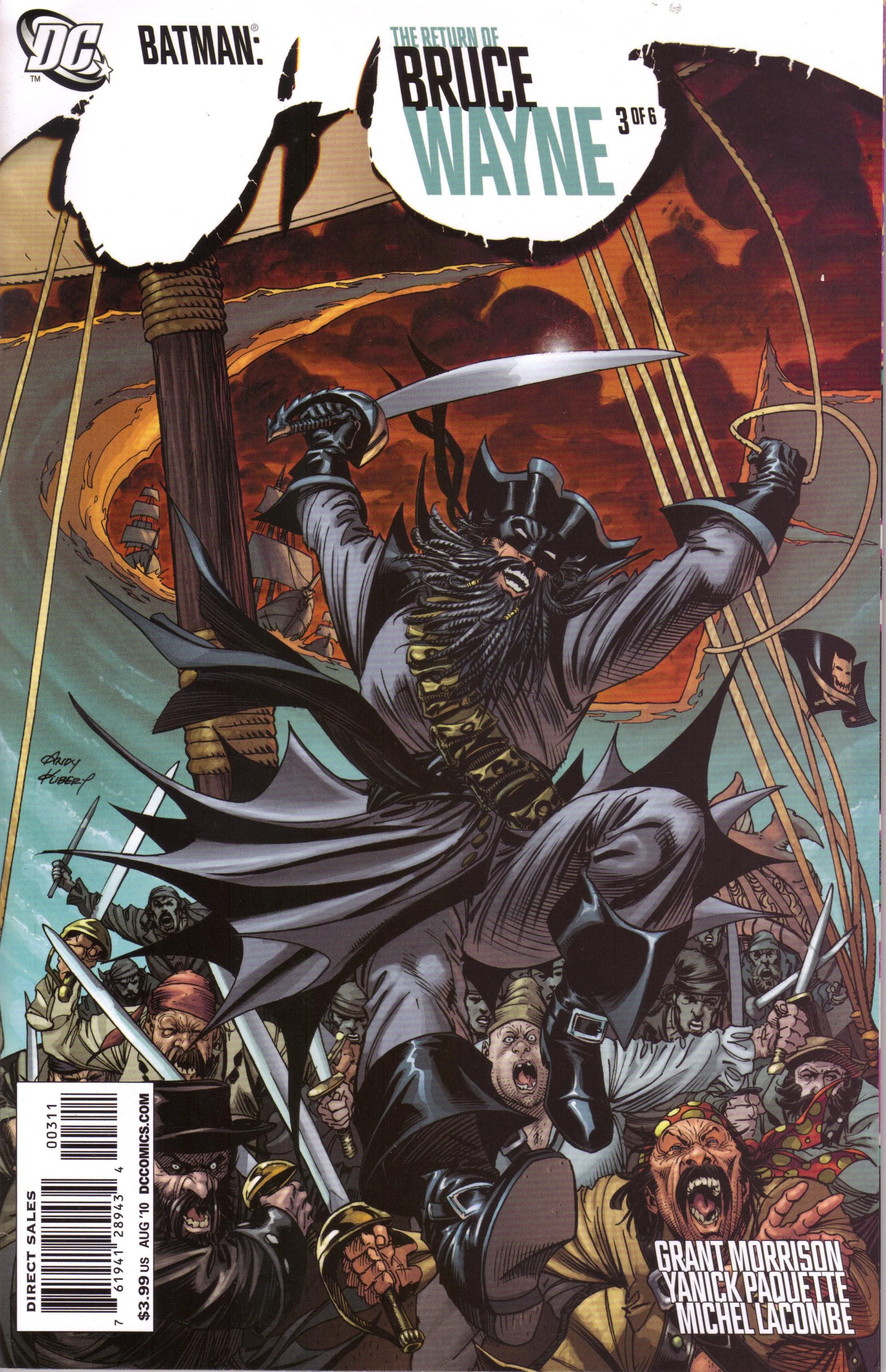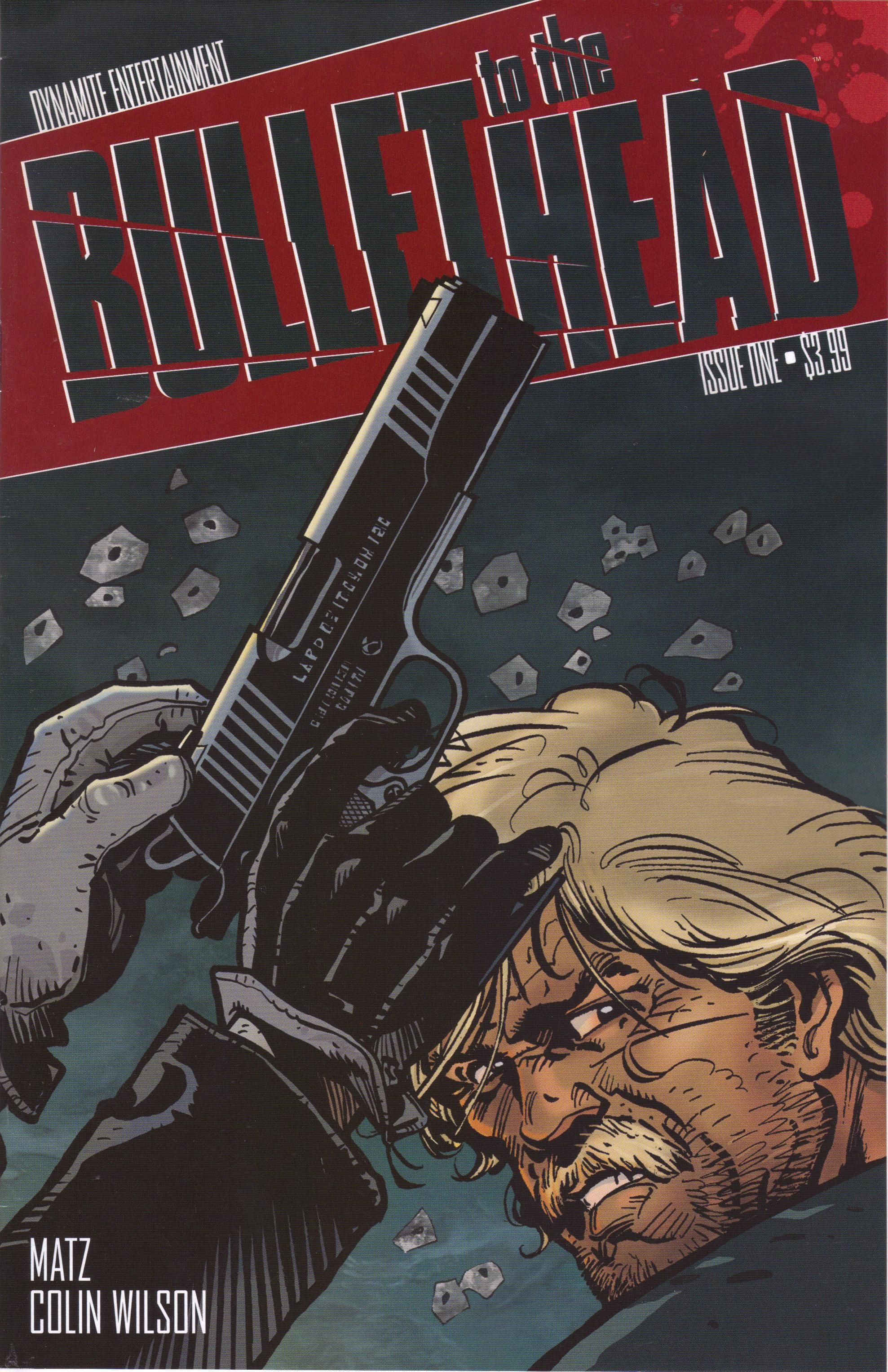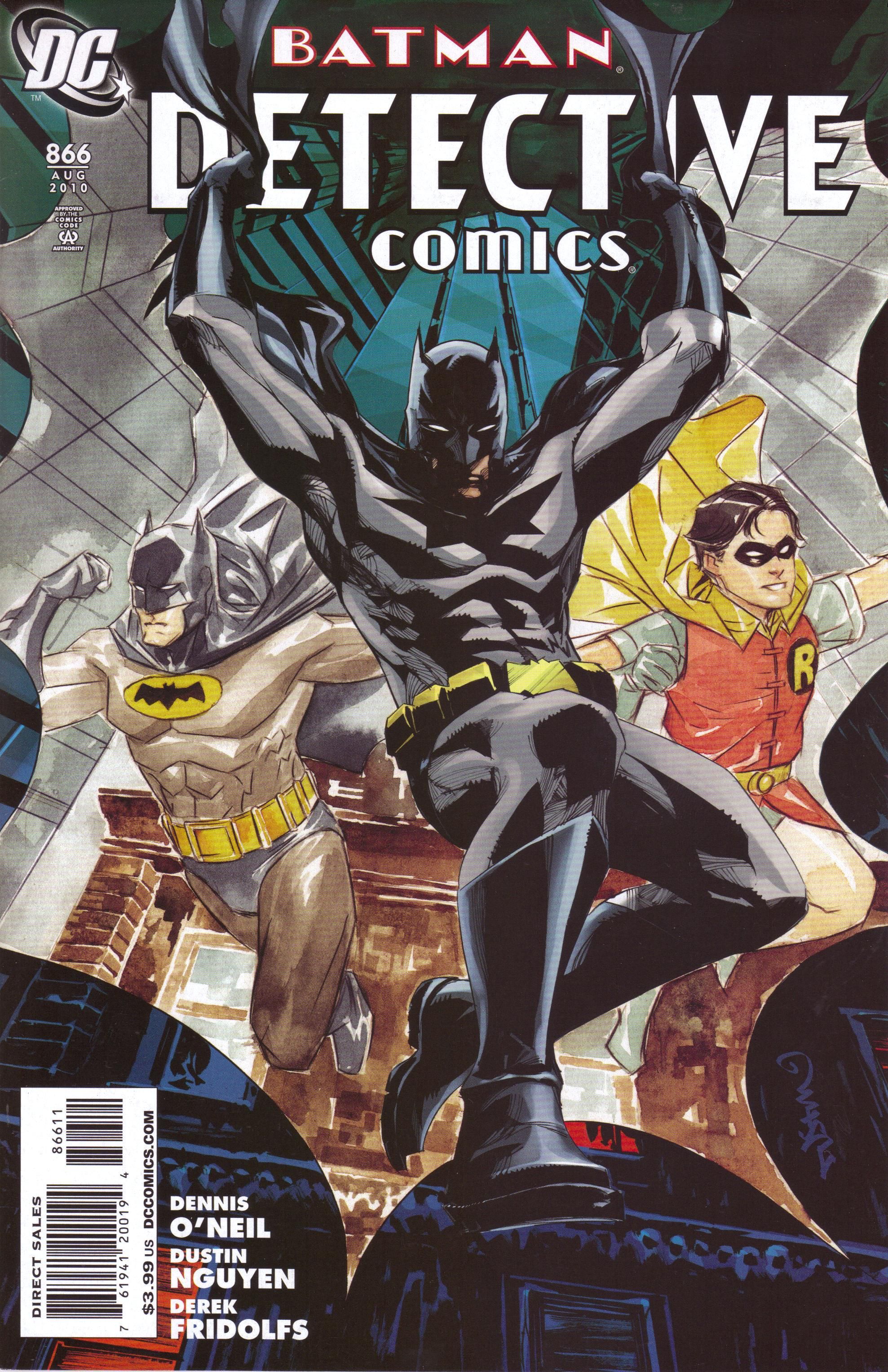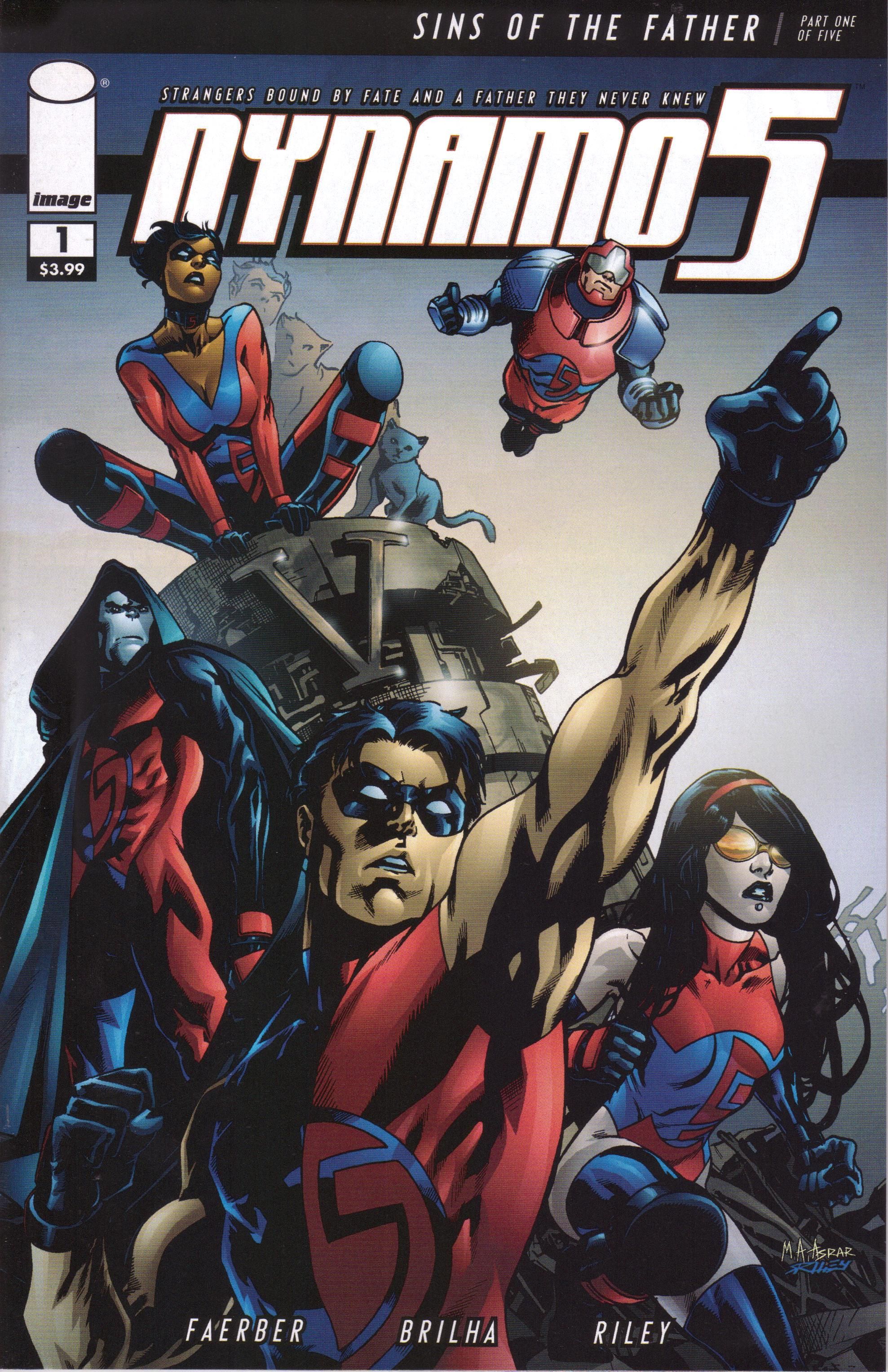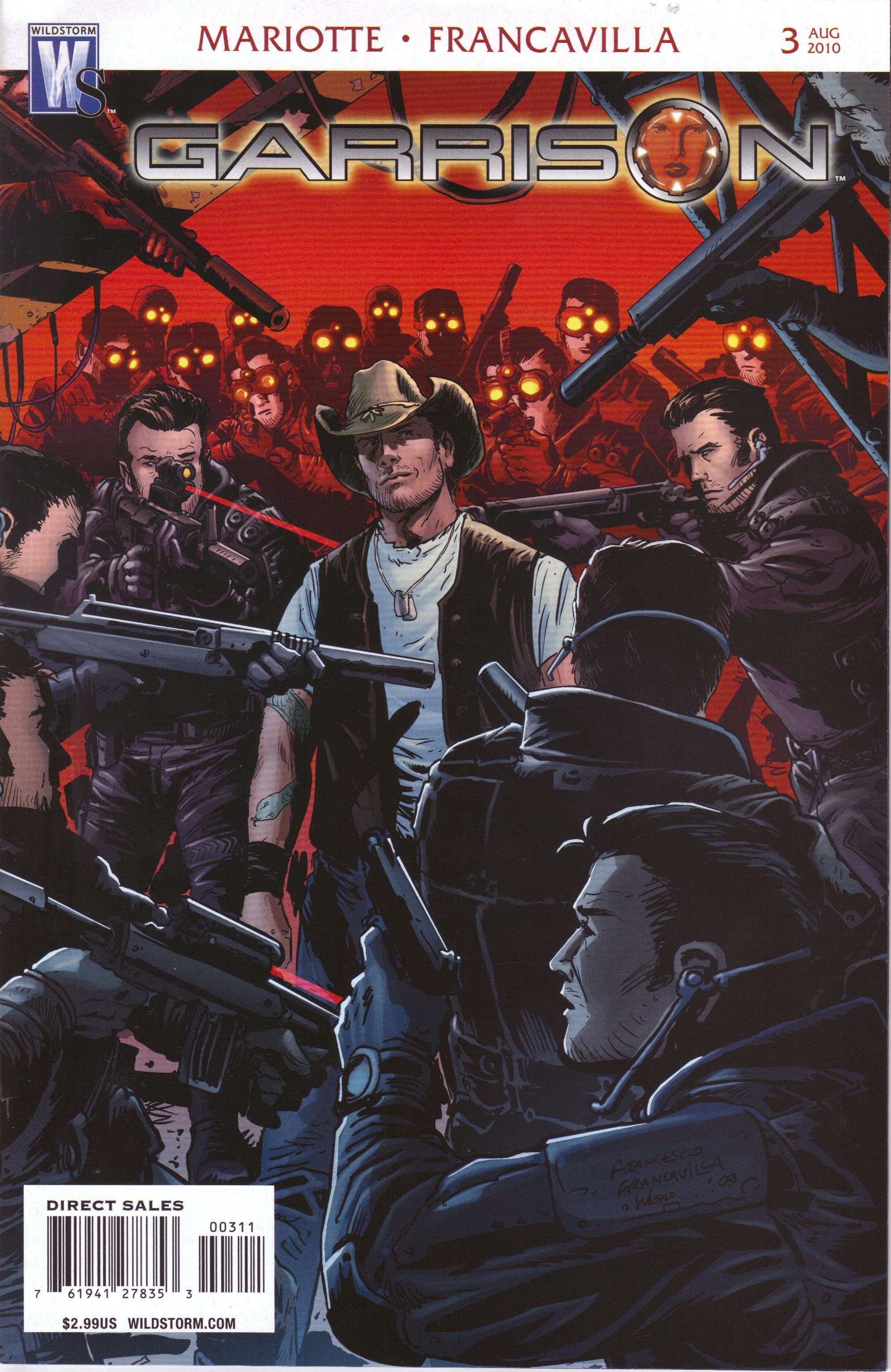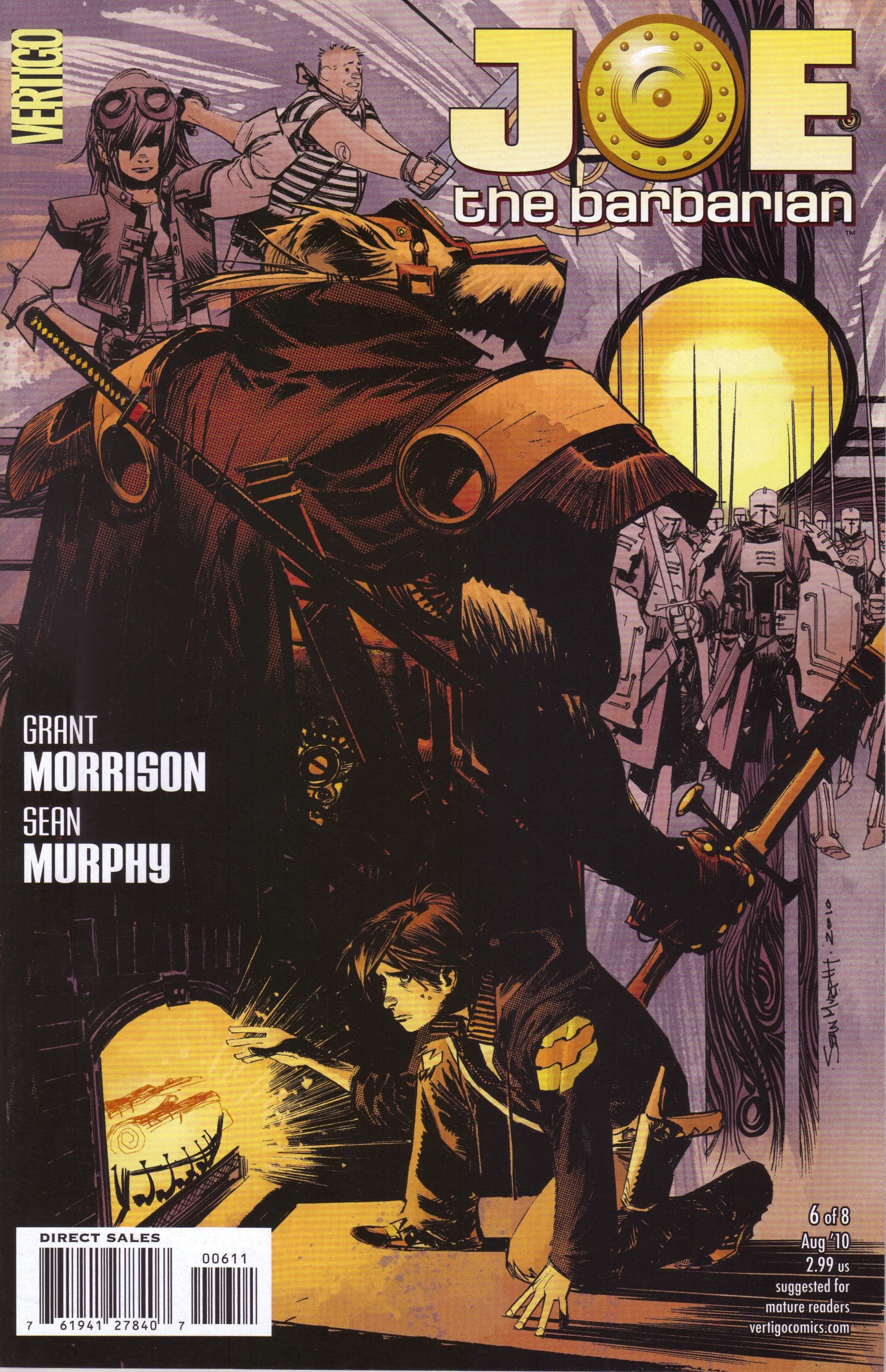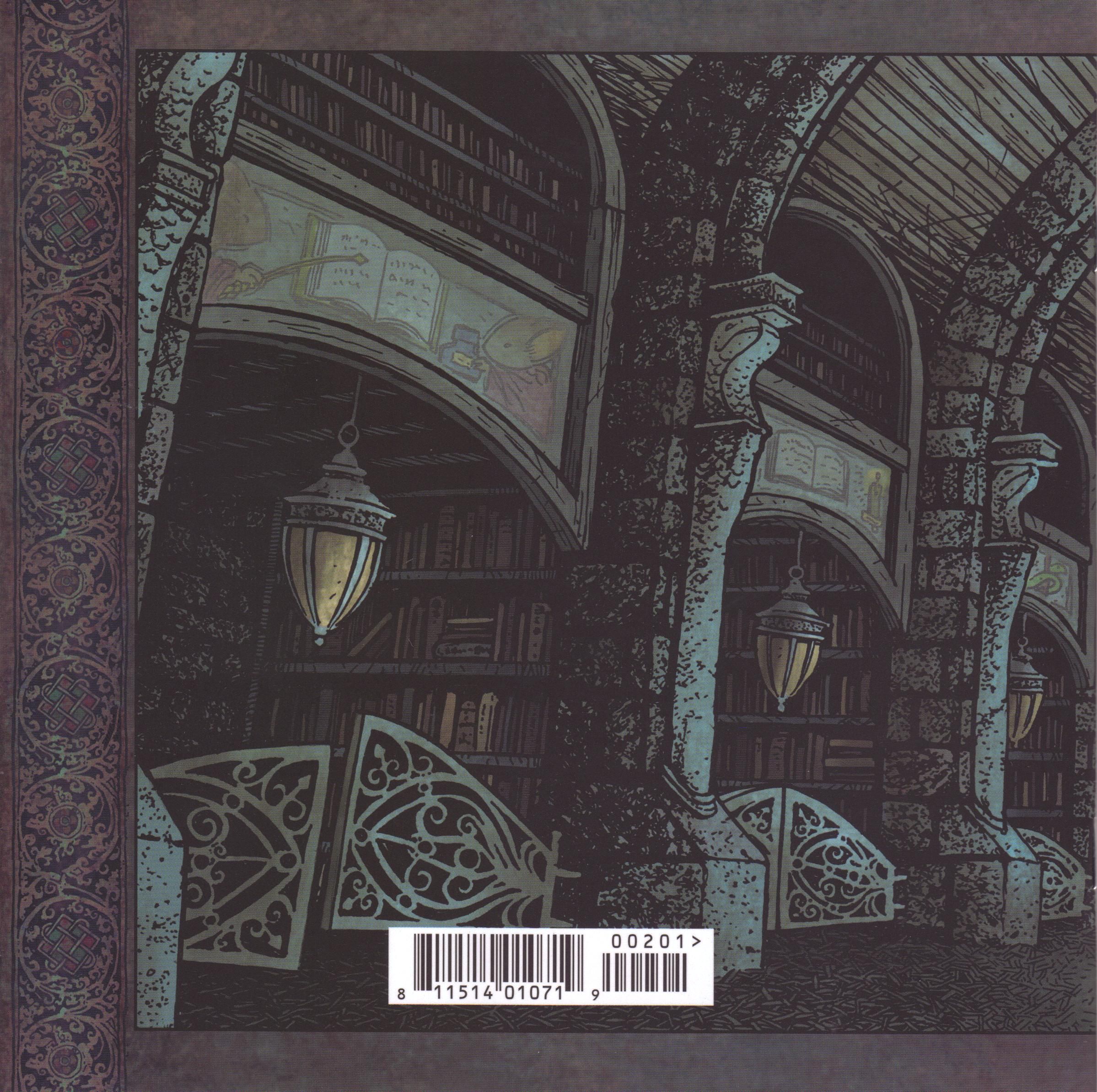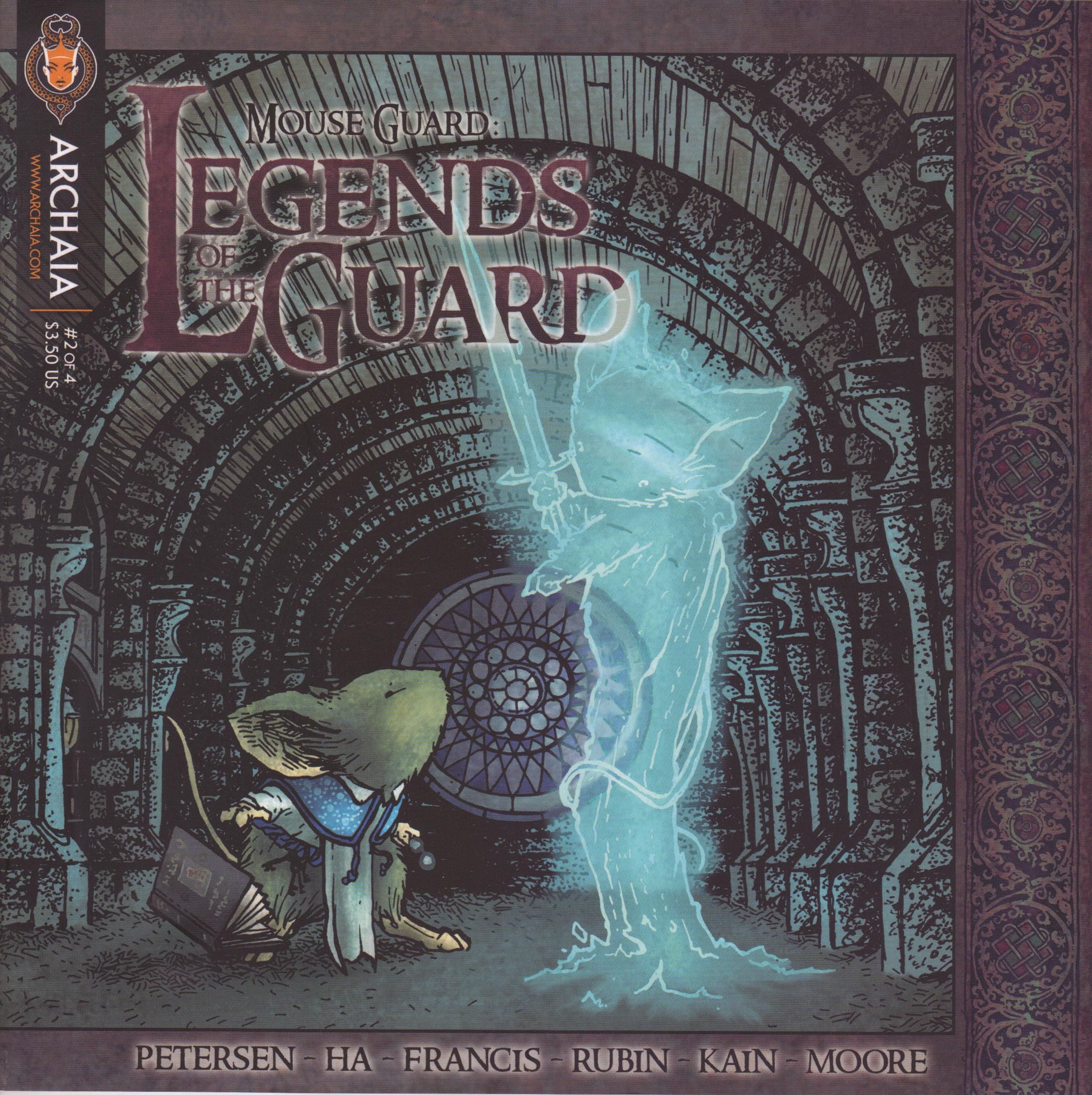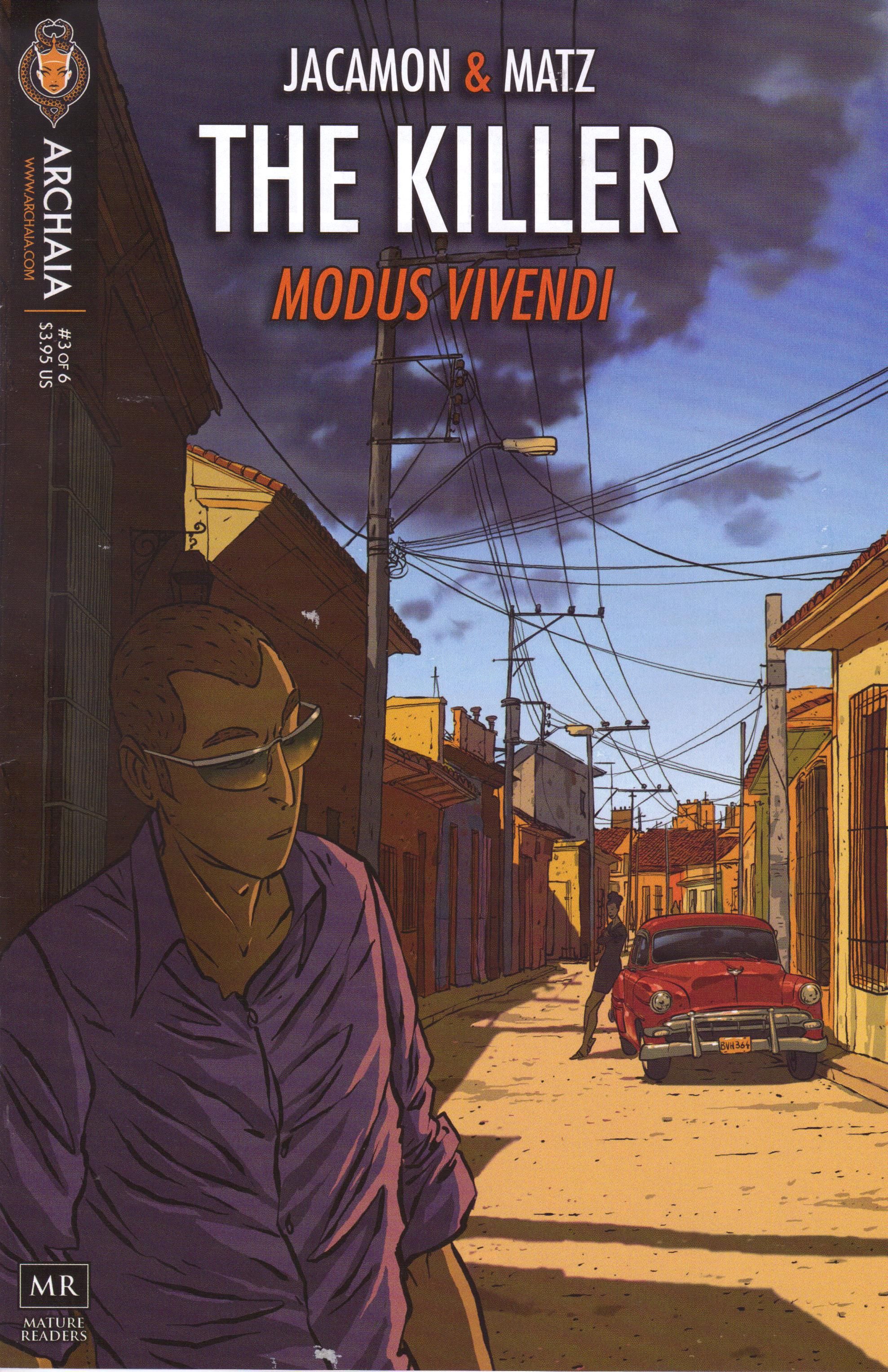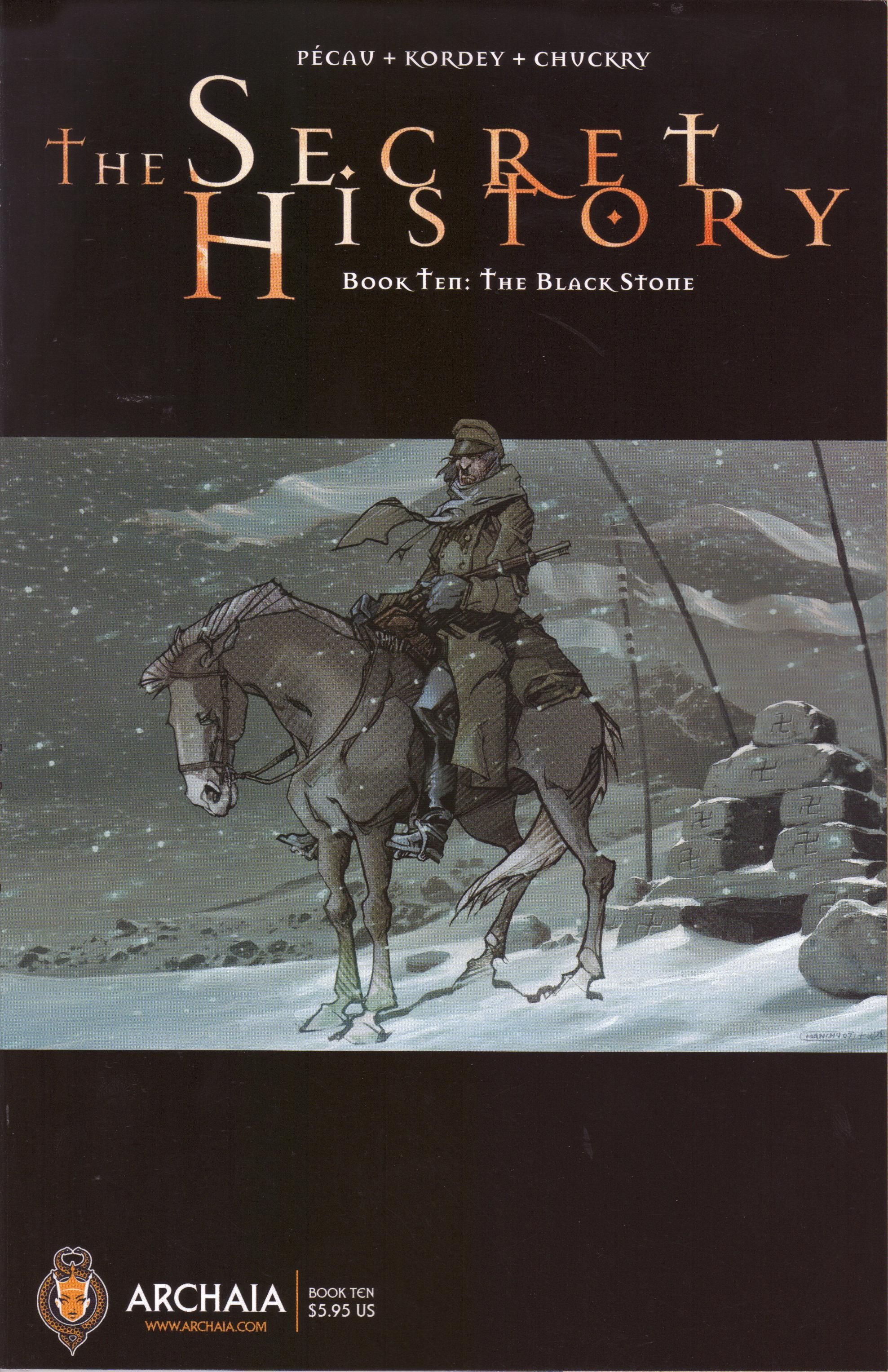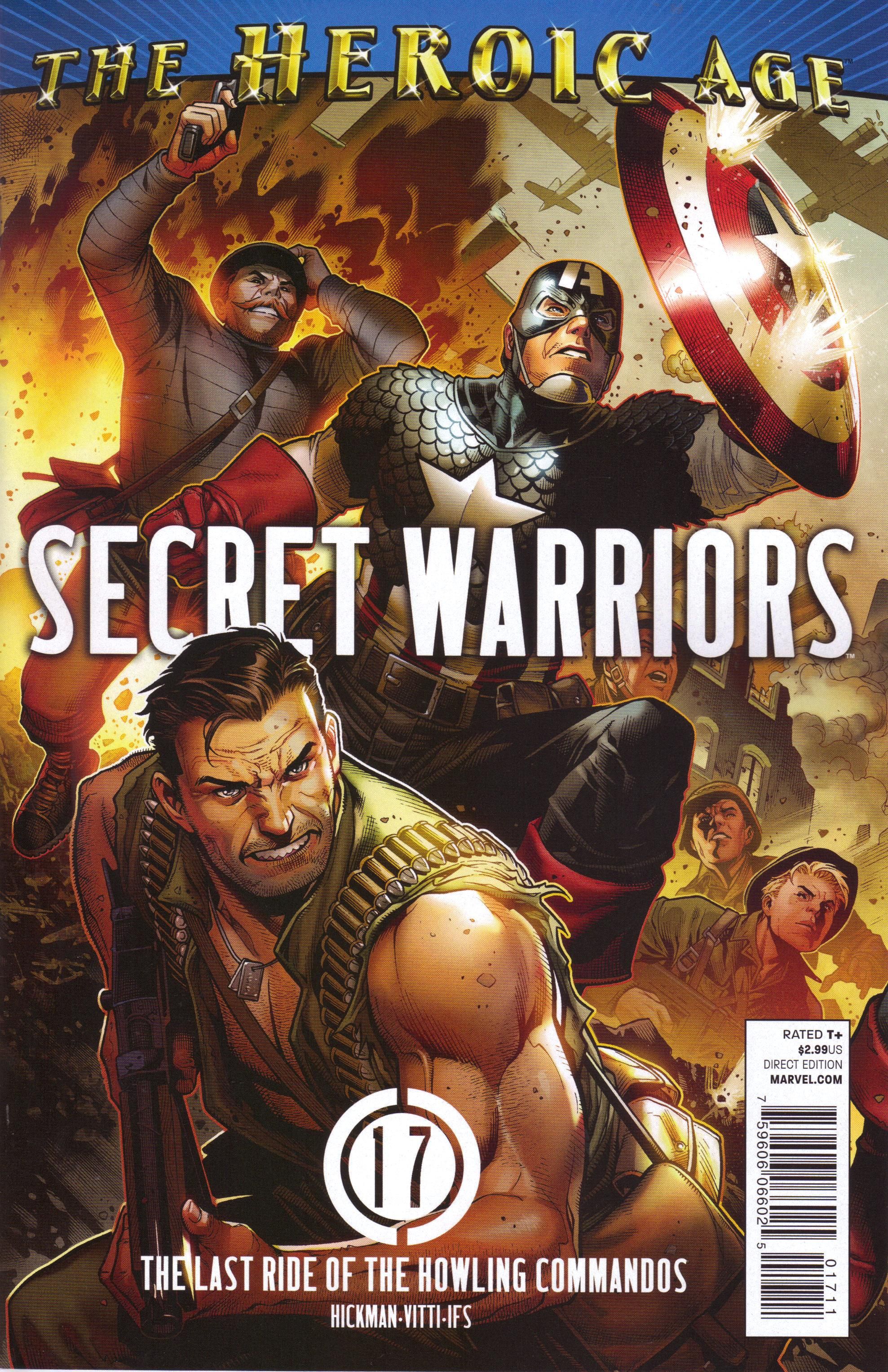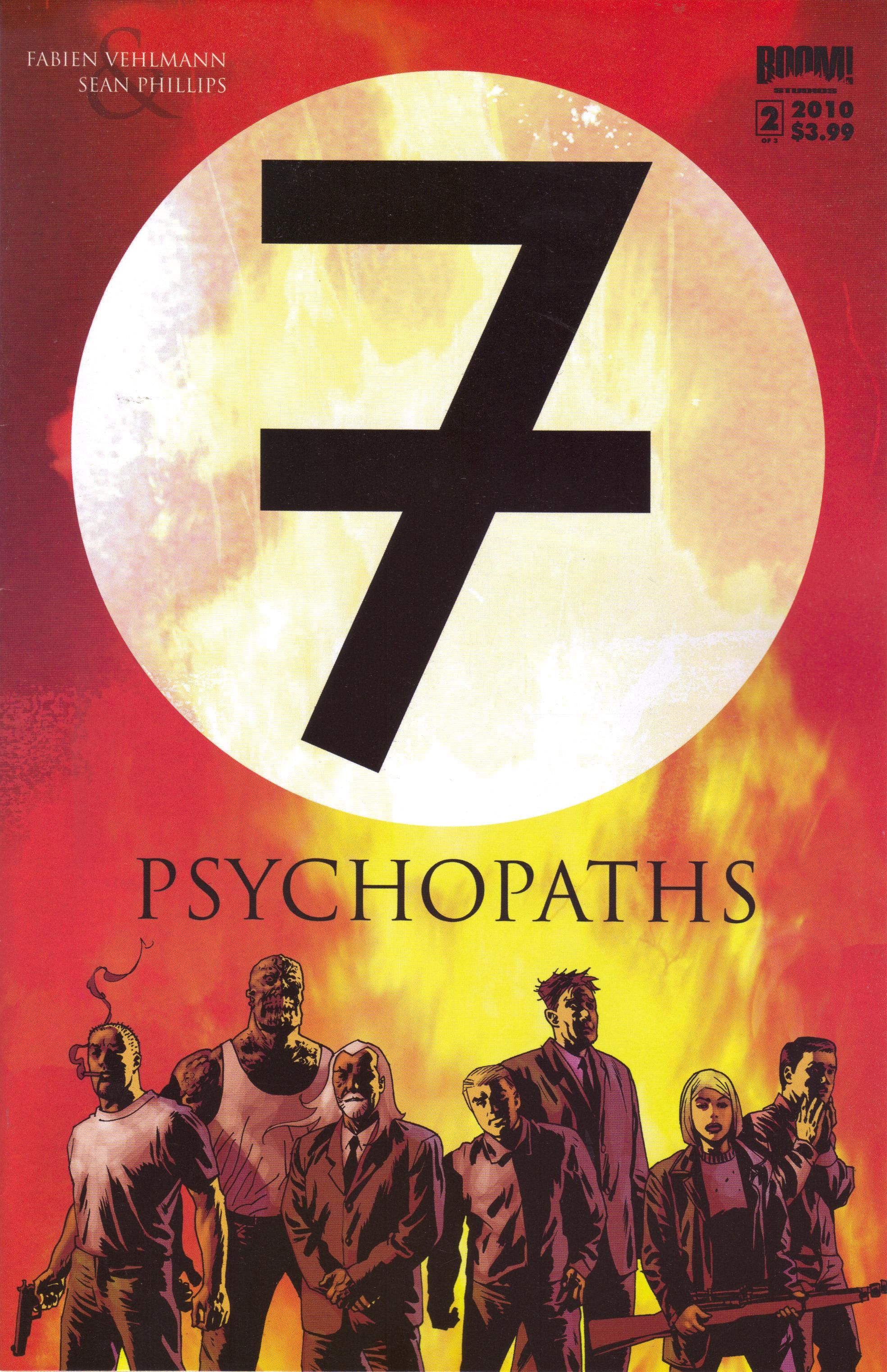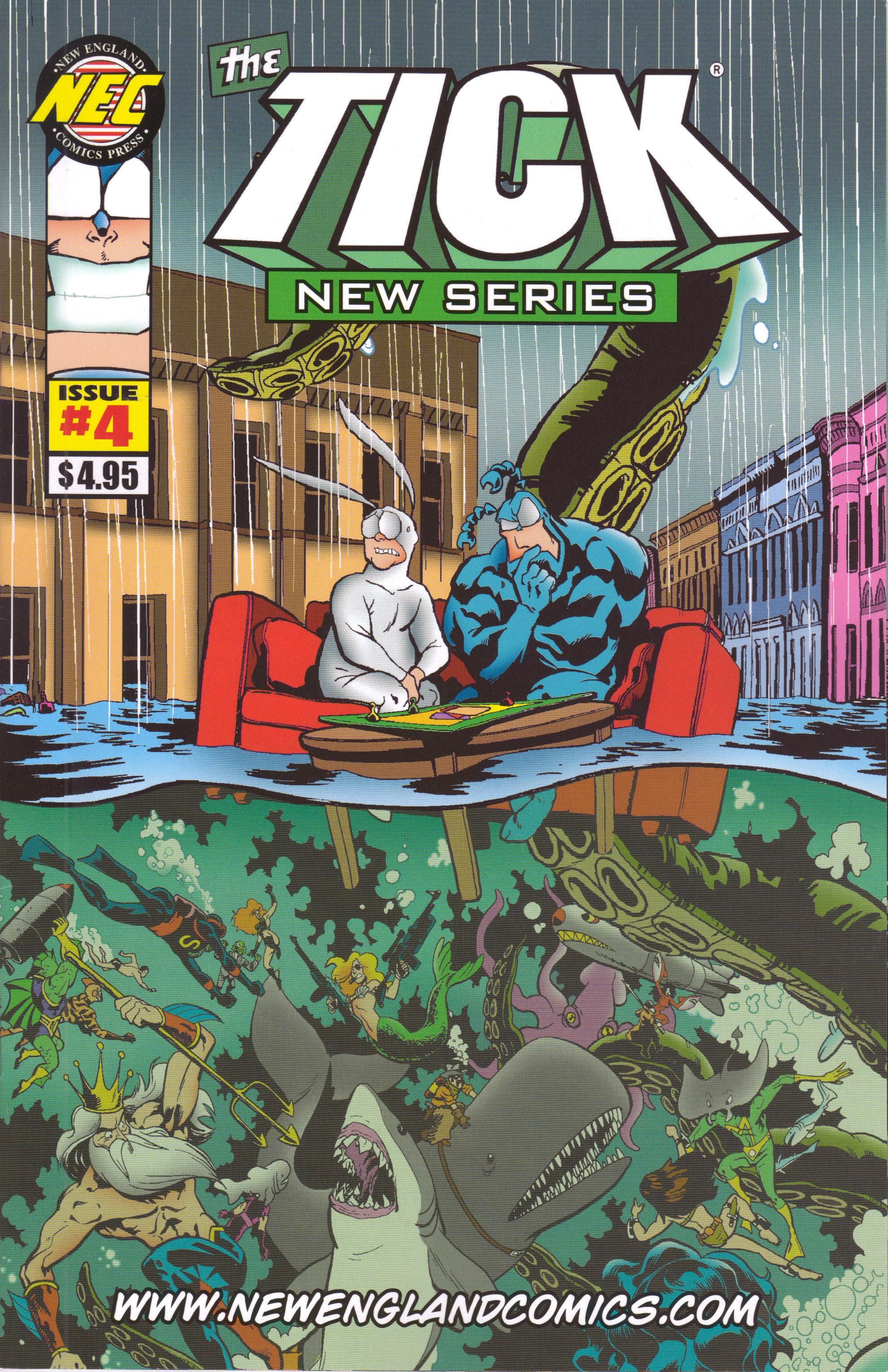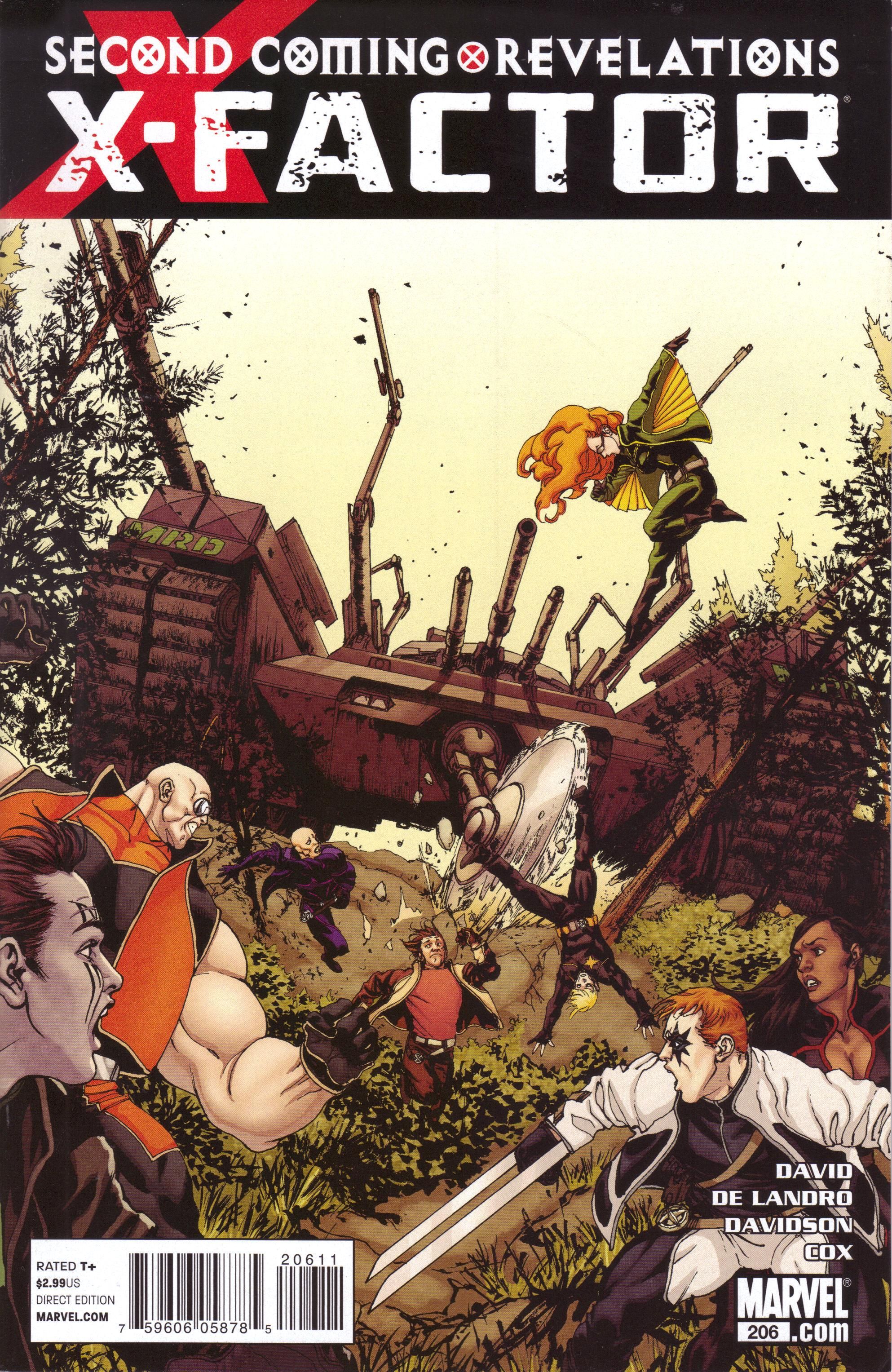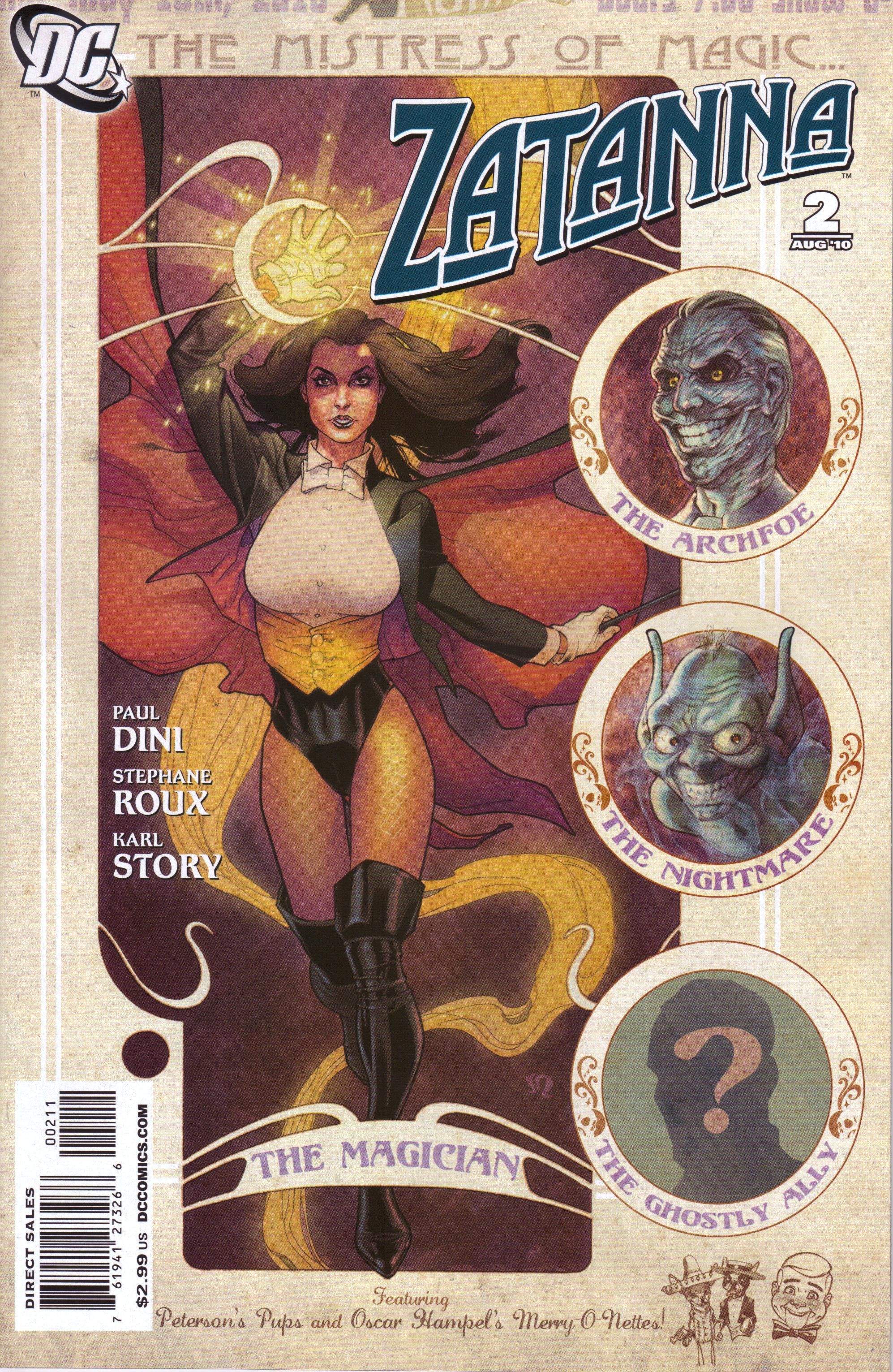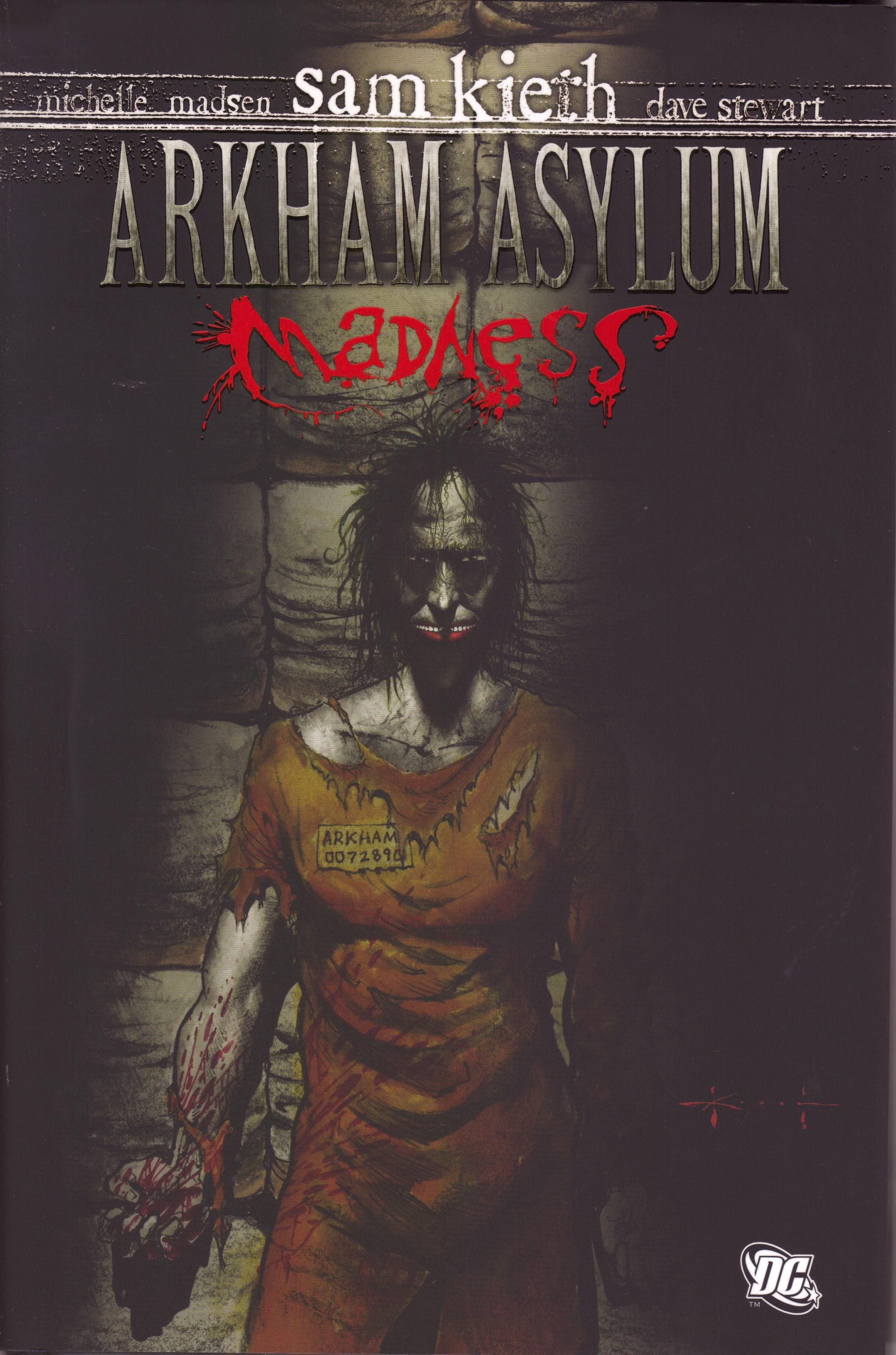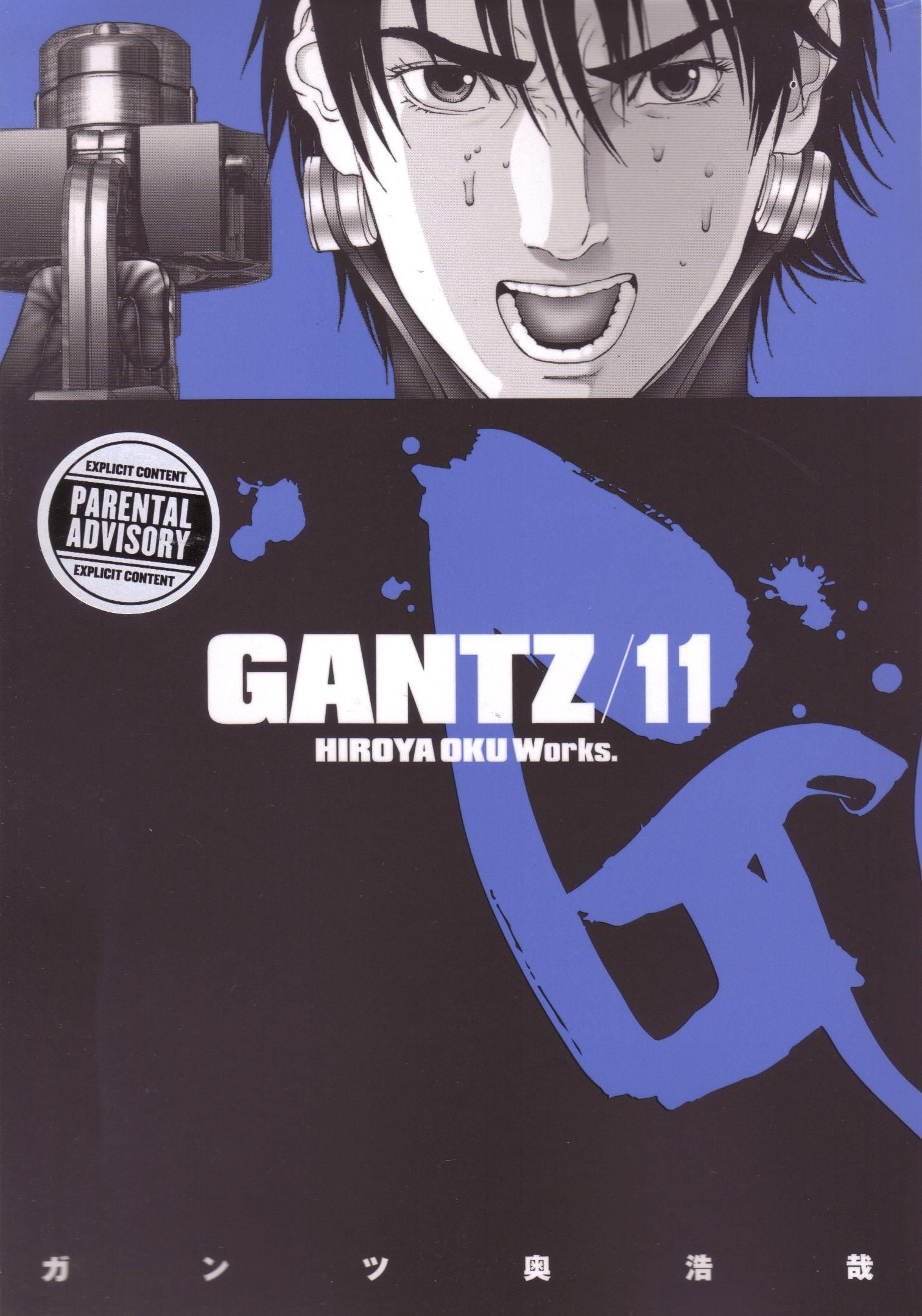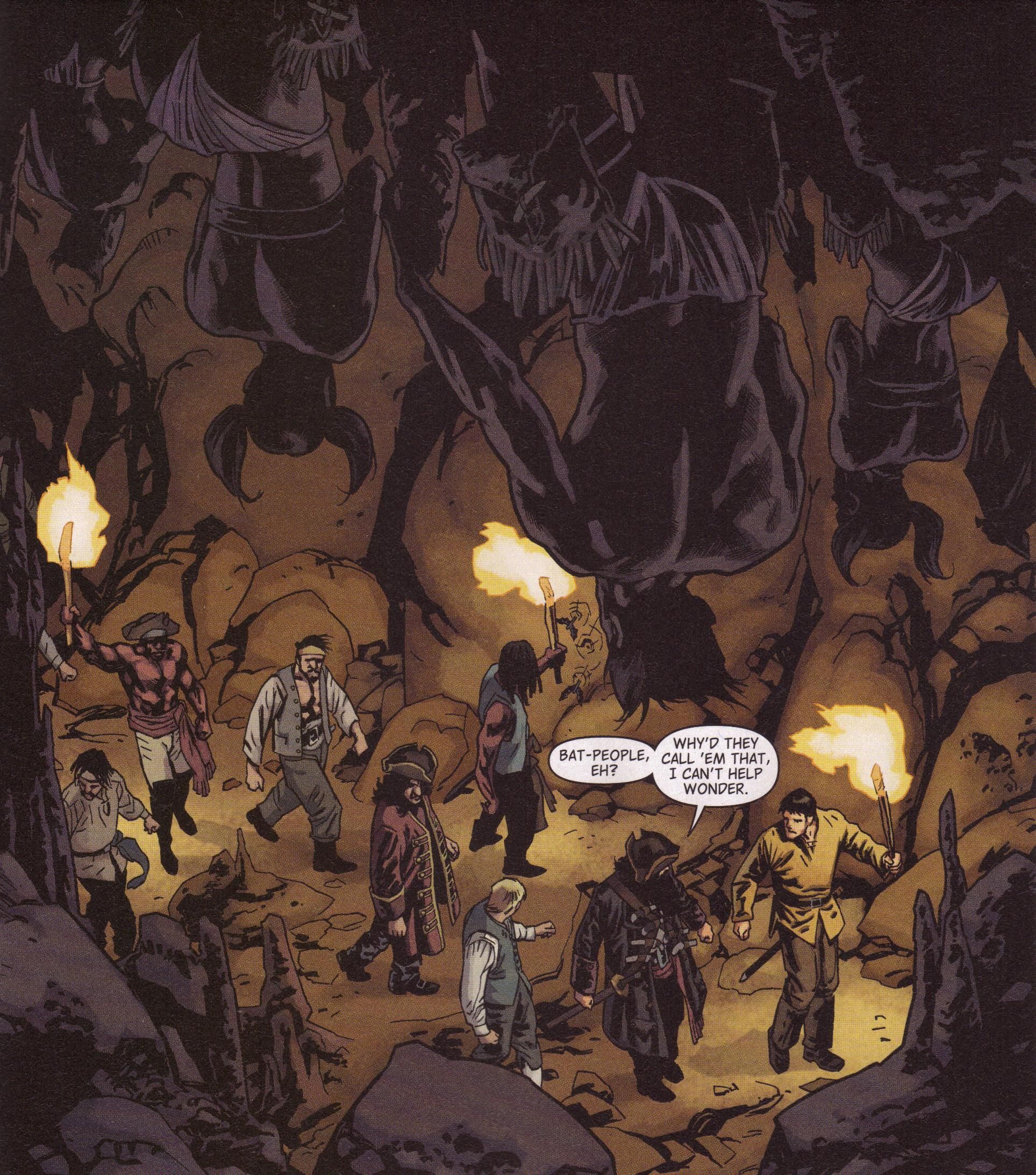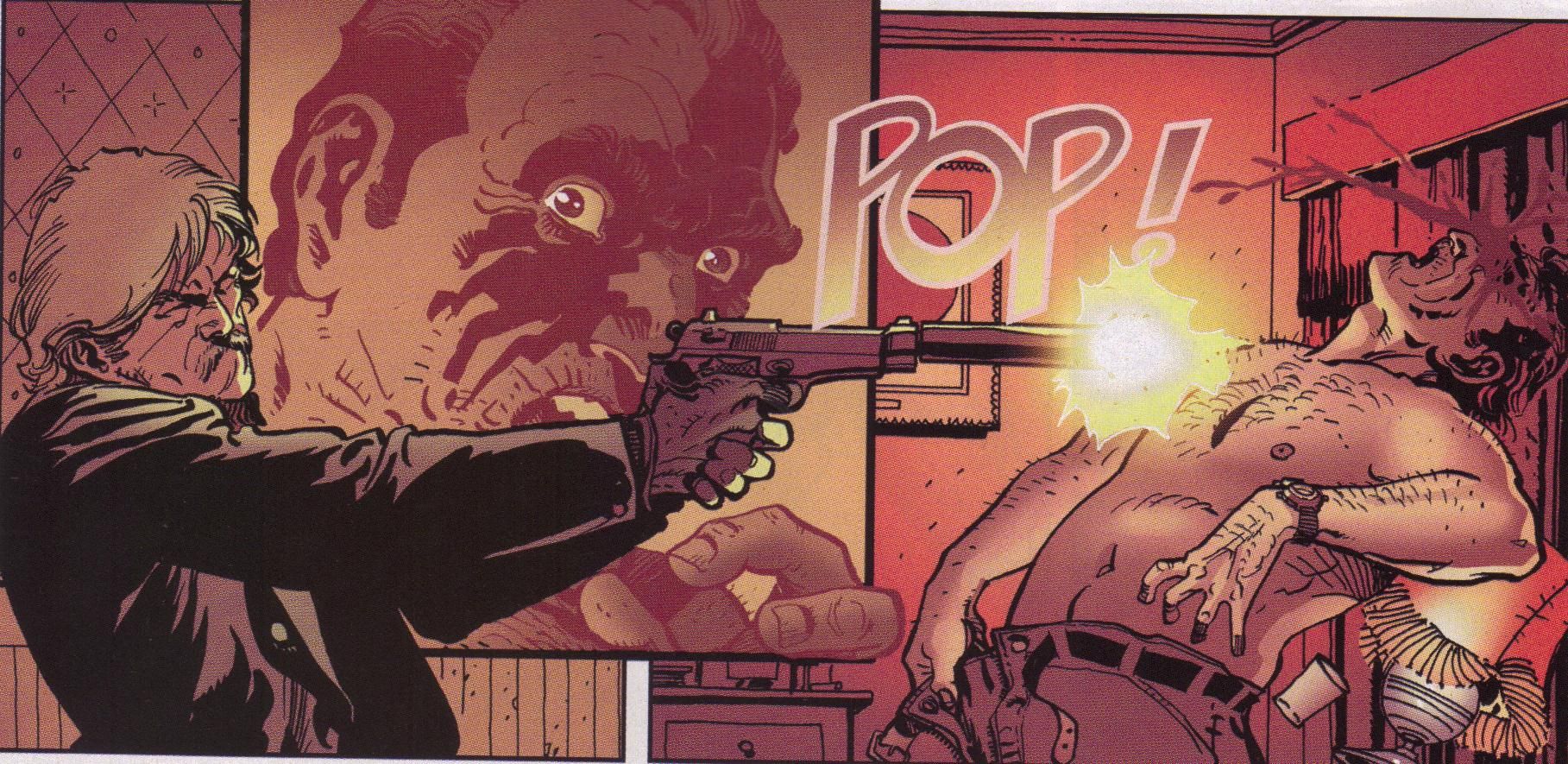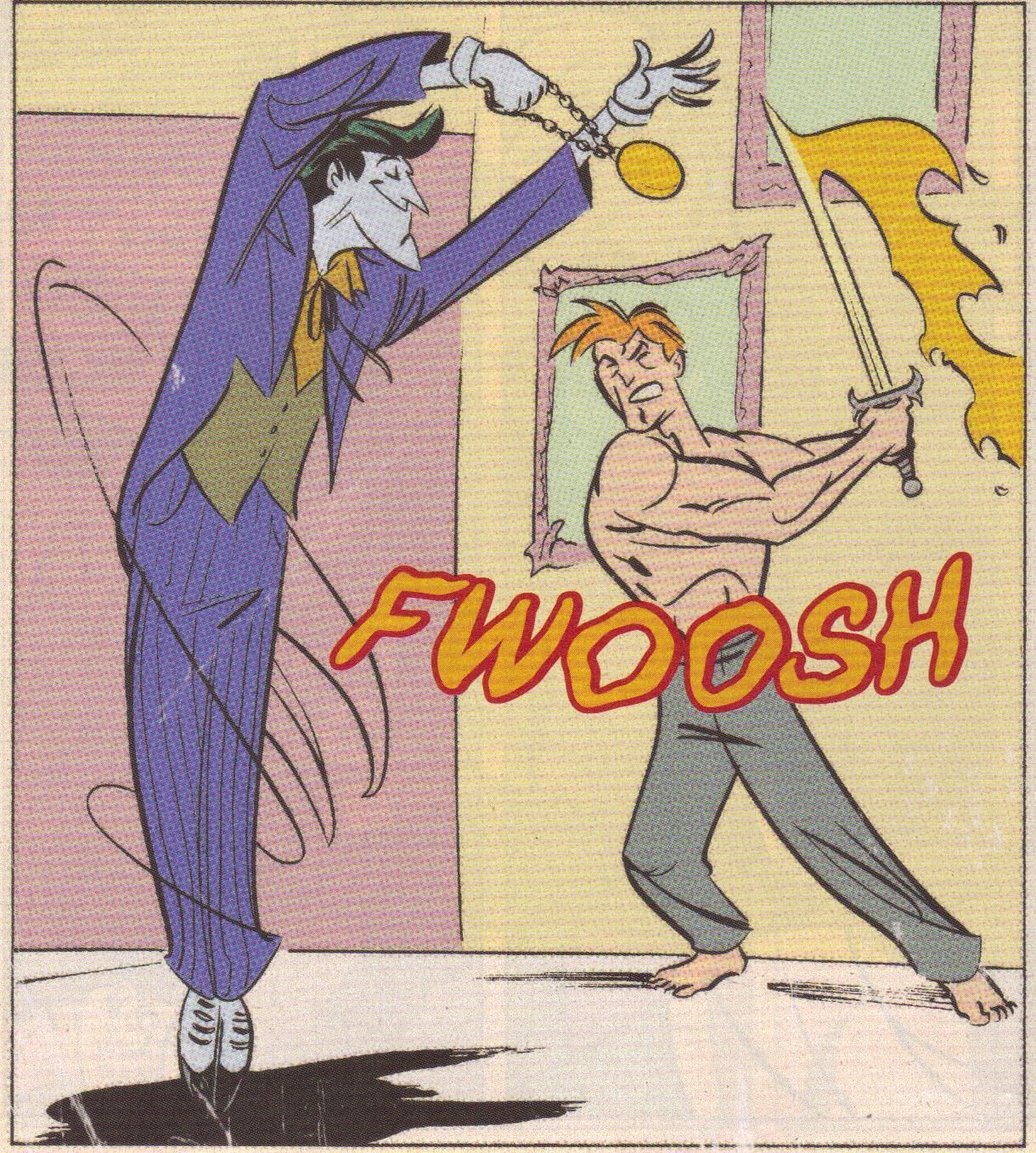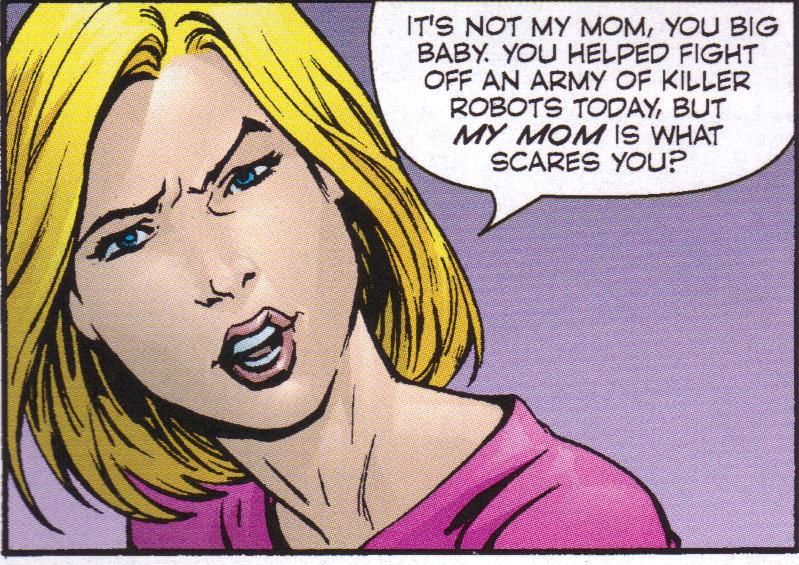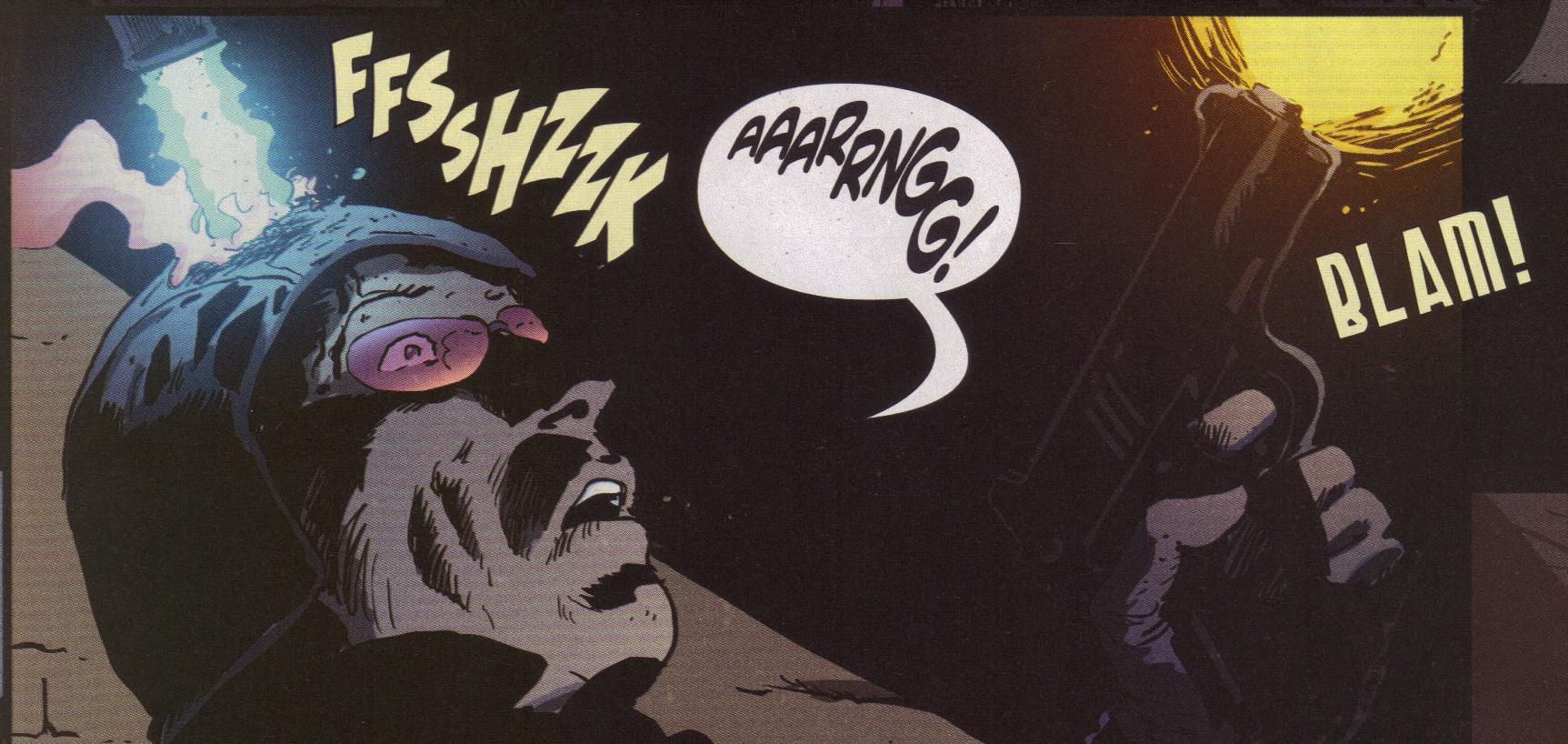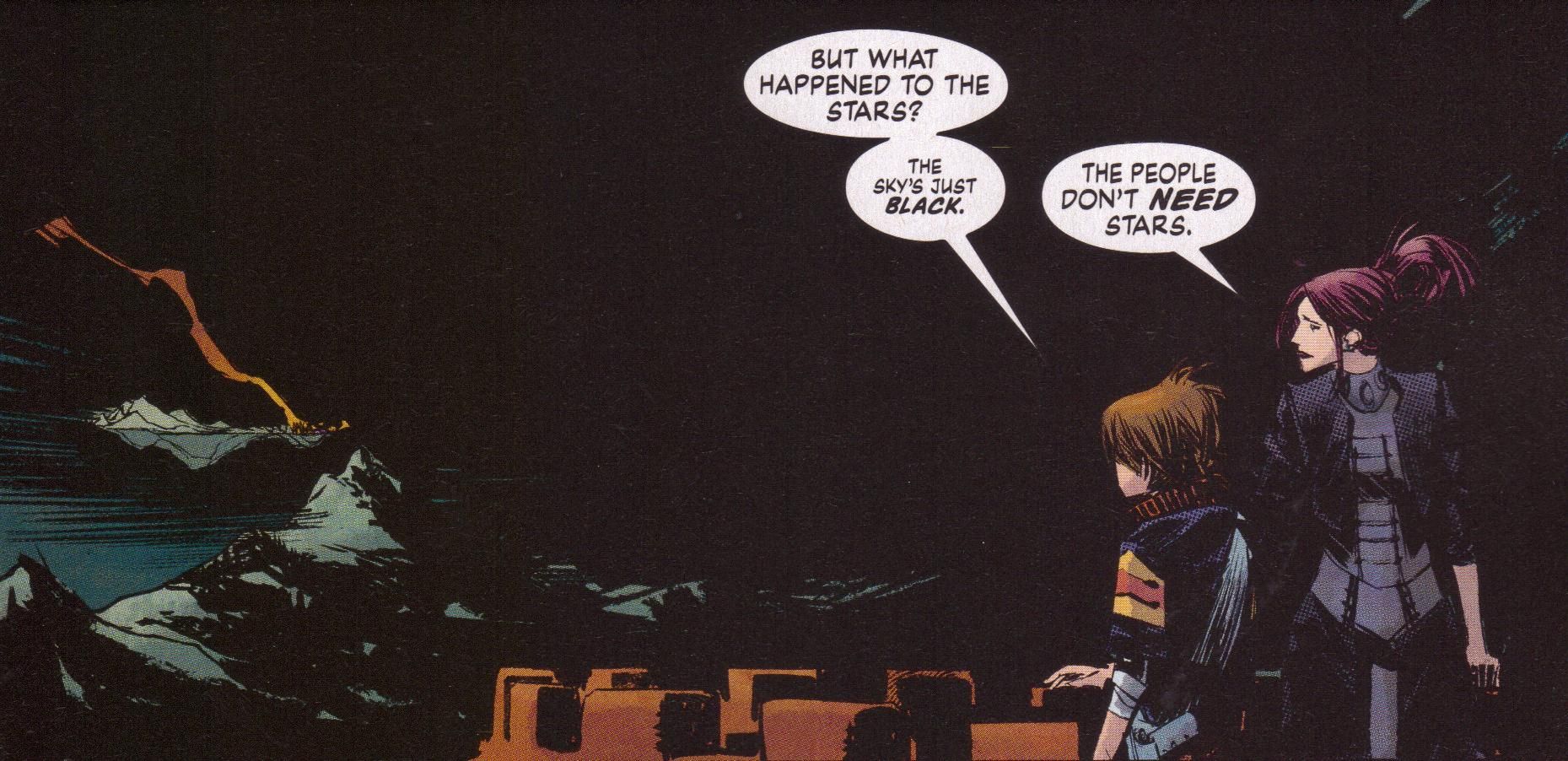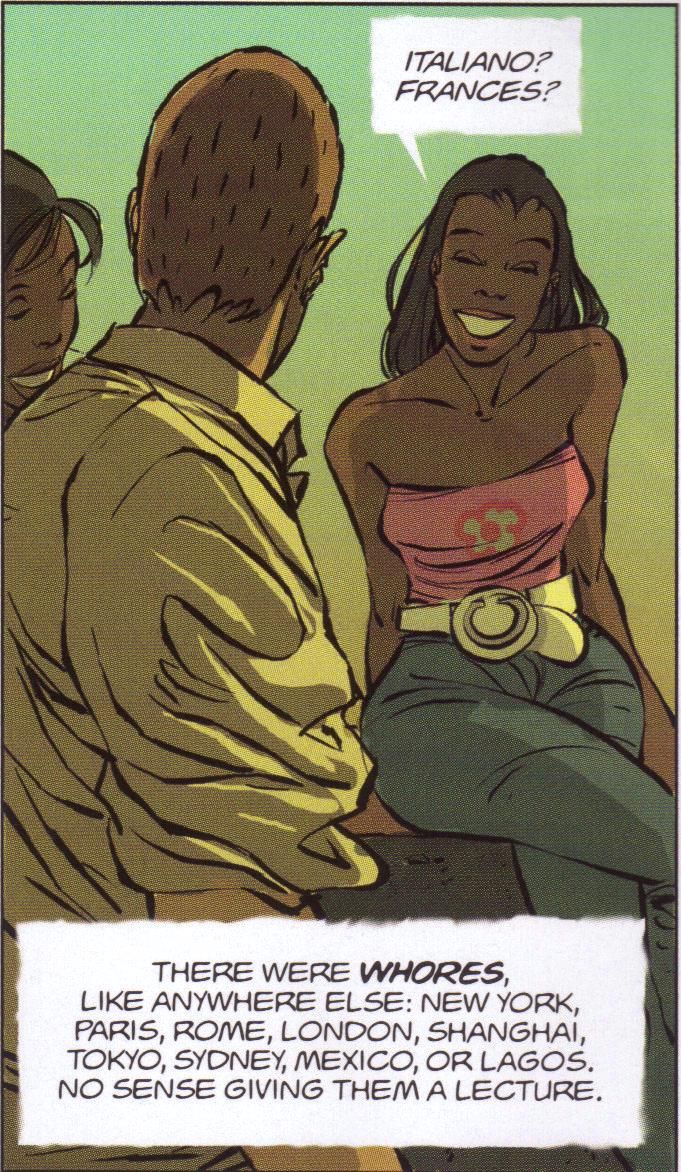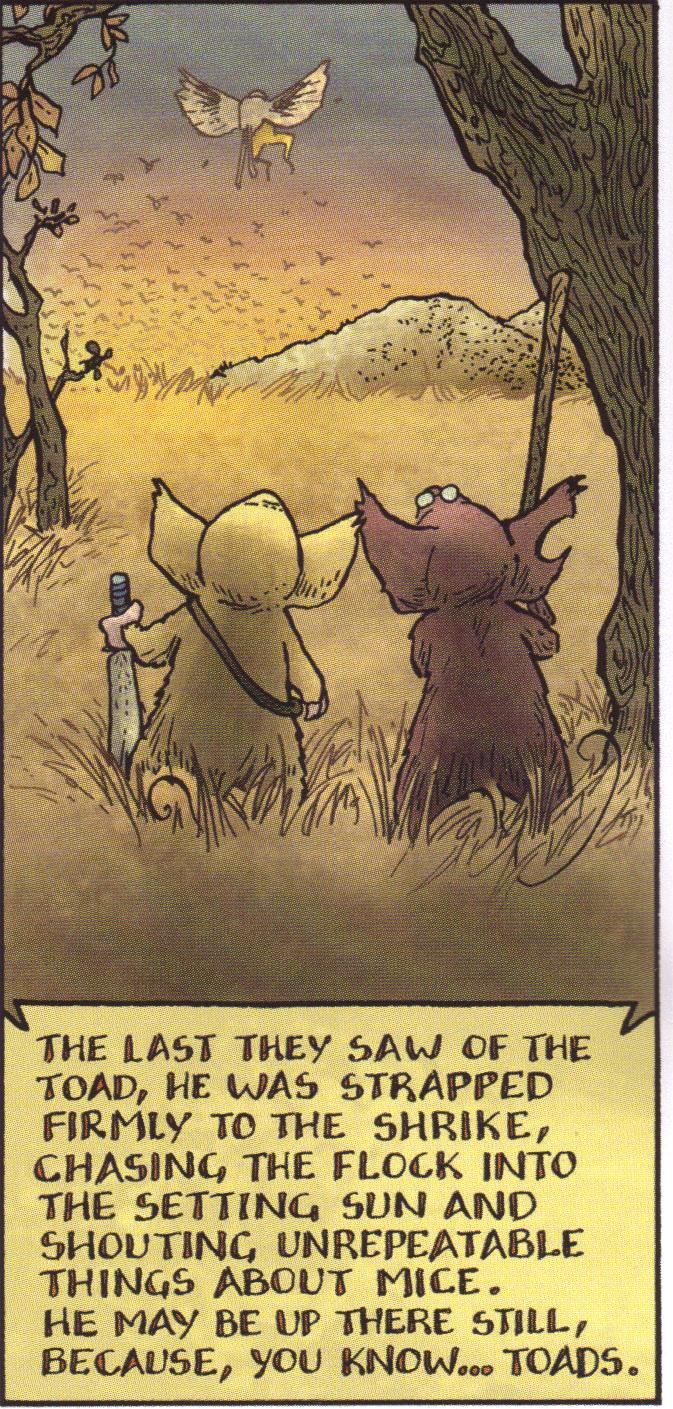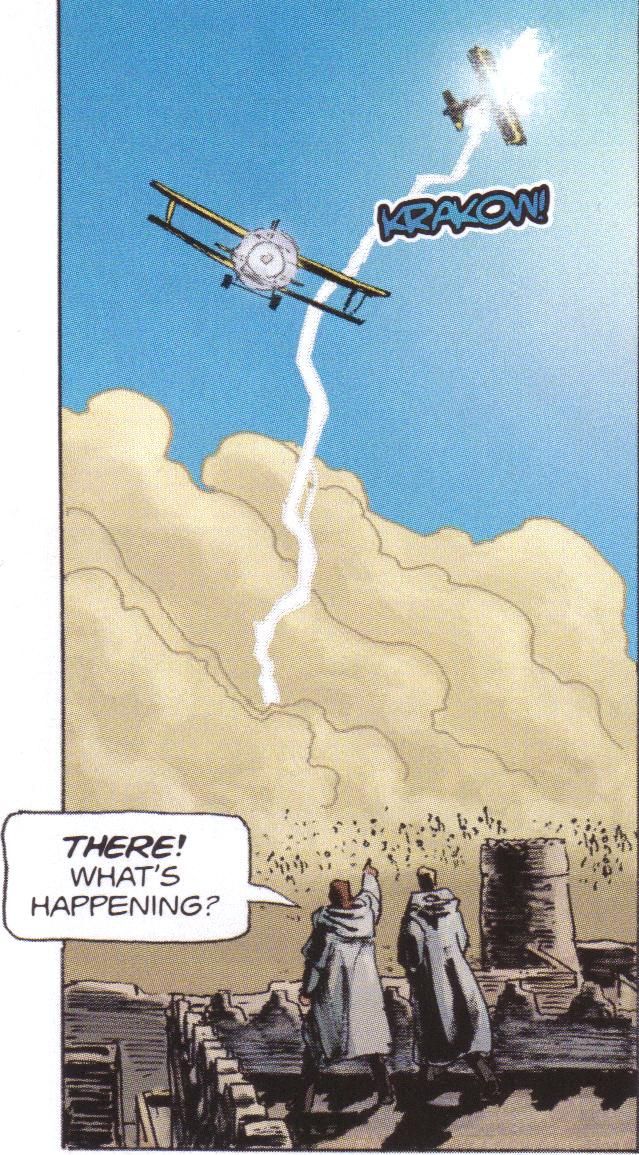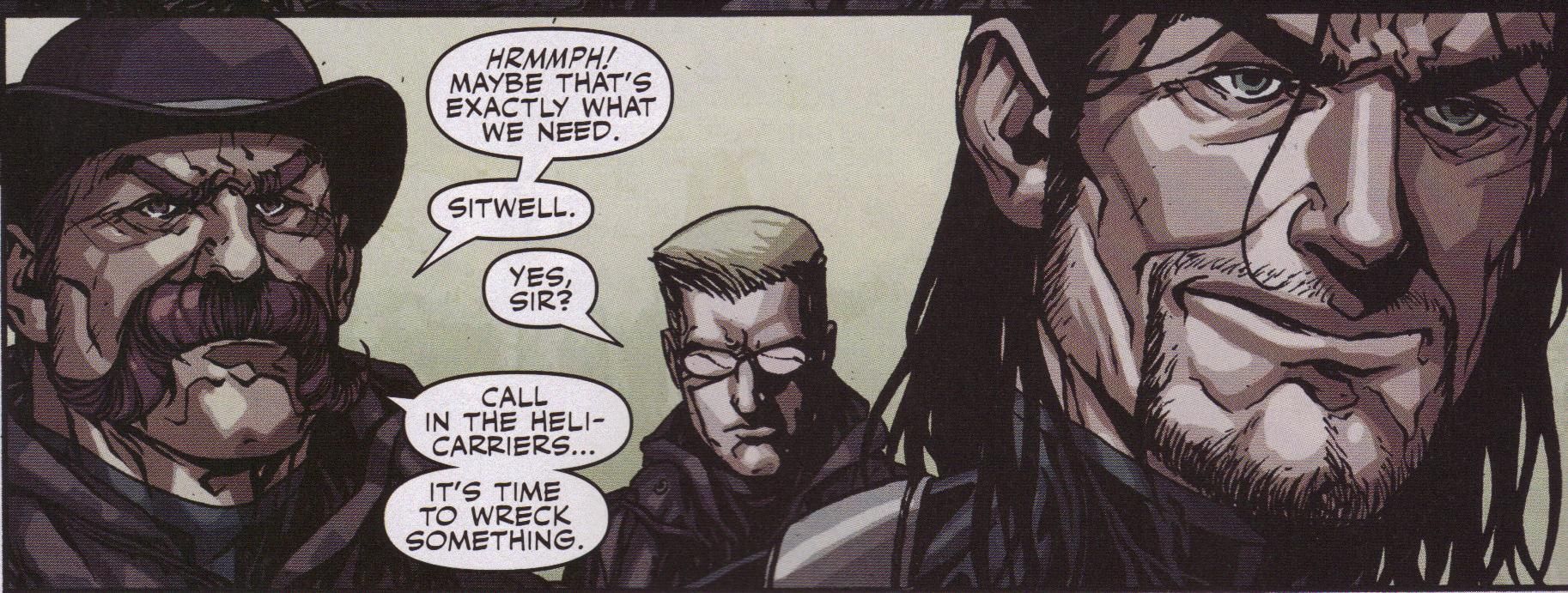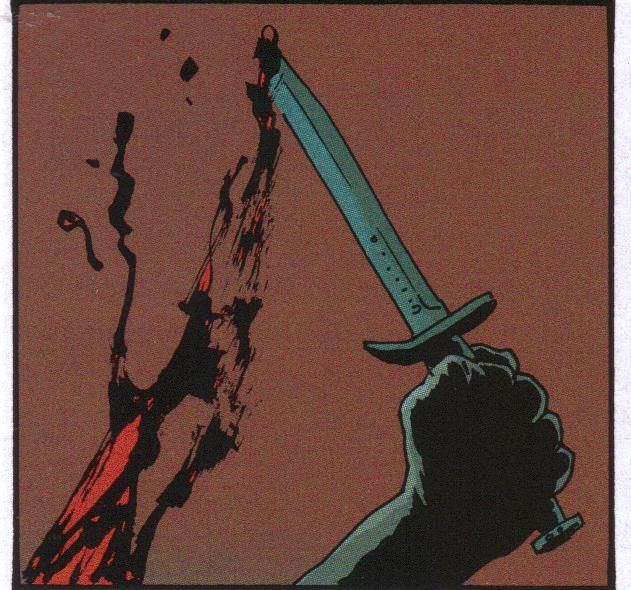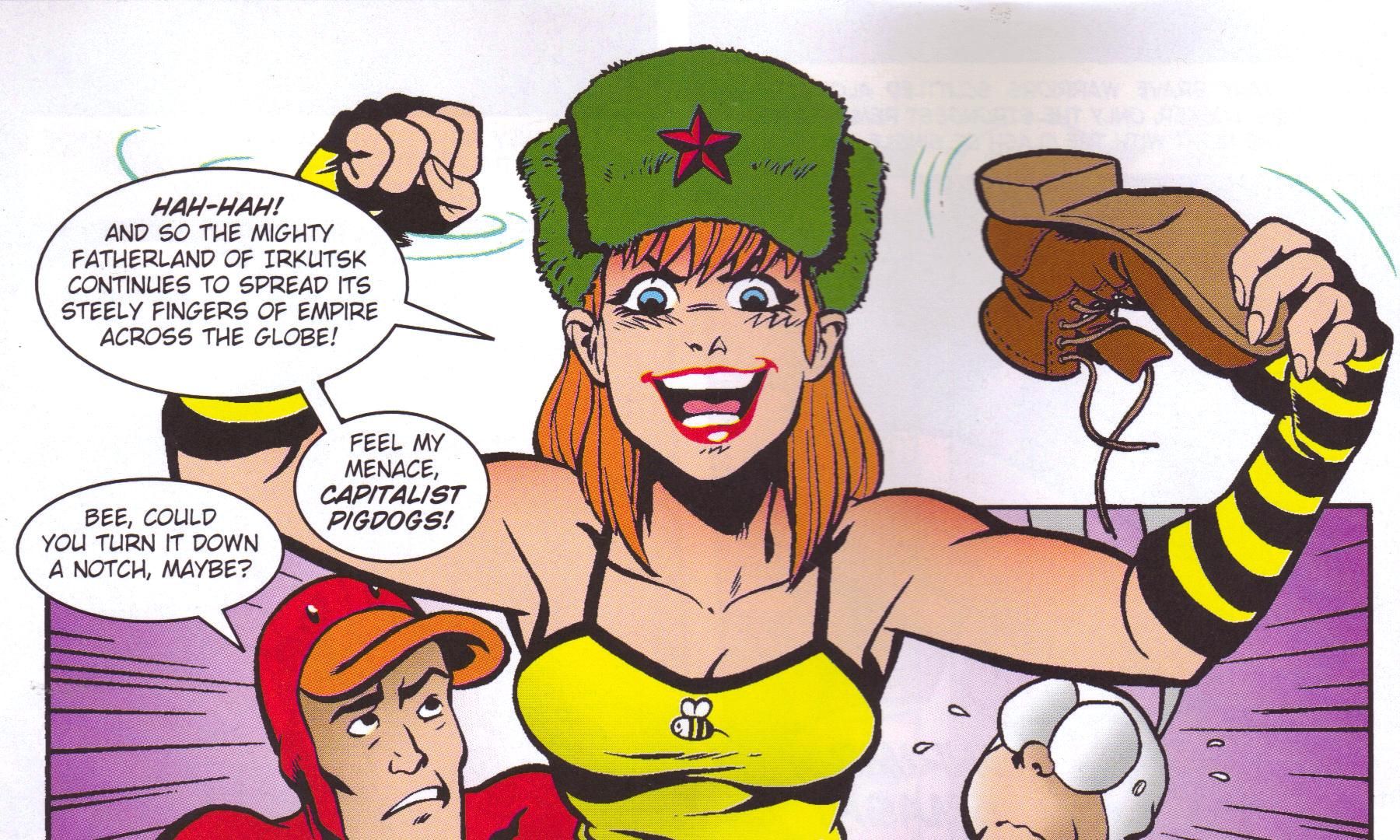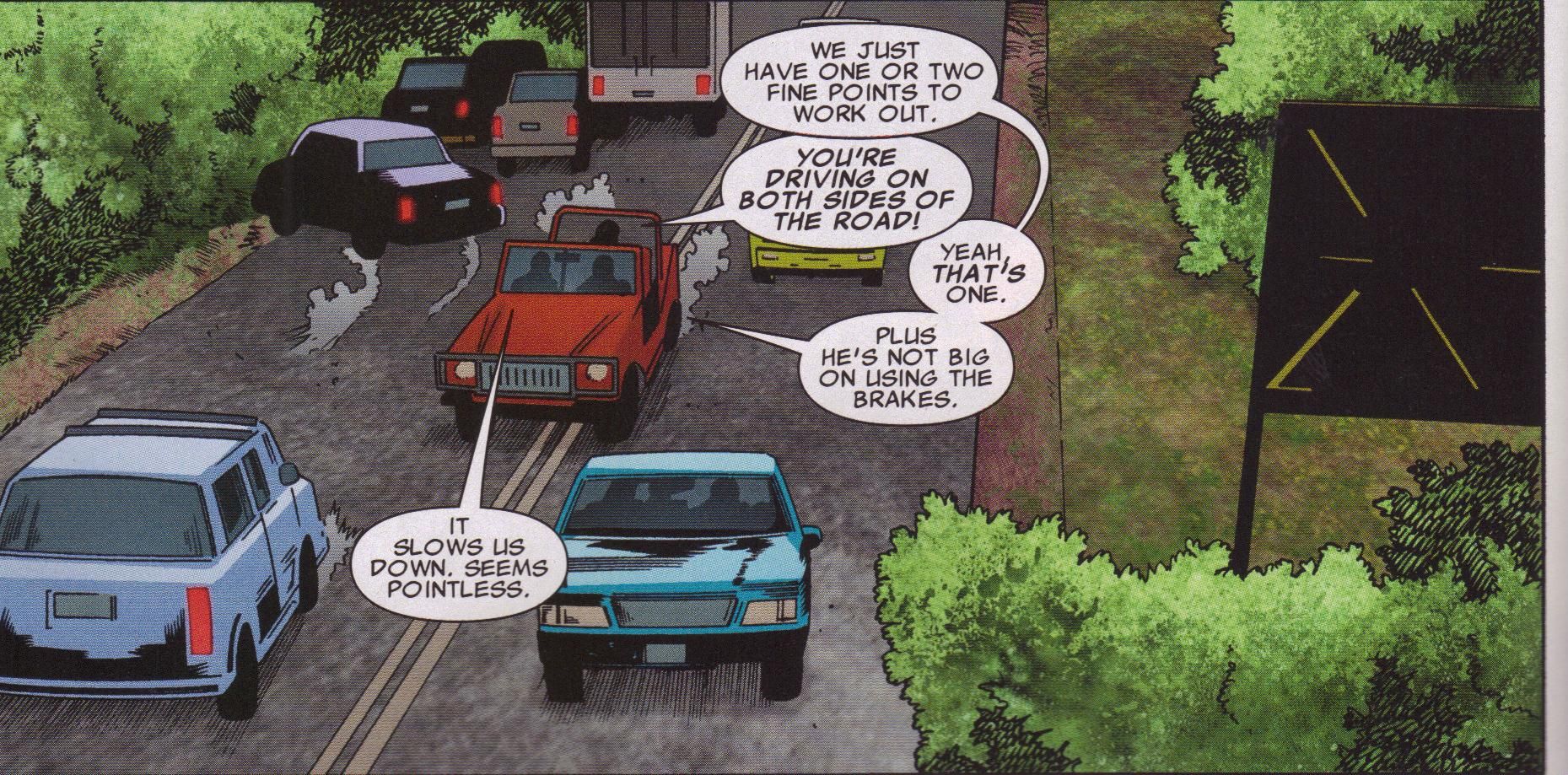"Concentration-camp existence ... taught us that the whole world is really like a concentration camp," wrote Tadeusz Borowski. "The weak work for the strong, and if they have no strength or will to work - then let them steal, or let them die. ... There is no crime that a man will not commit in order to save himself. And, having saved himself, he will commit crimes for increasingly trivial reasons; he will commit them first out of duty, then from habit, and finally - for pleasure. ... The world is ruled by neither justice nor morality; crime is not punished nor virtue rewarded, one is forgotten as quickly as the other. The world is ruled by power ..." (Otto Friedrich, from The End of the World)
Batman: The Return of Bruce Wayne #3 (of 6) ("The Bones of Bristol Bay") by Grant "Have I blown up your brain yet, fanboys?" Morrison (writer), Yanick Paquette (penciller), Michel Lacombe (inker), Nathan Fairbairn (colorist), and Jared K. Fletcher (letterer). $3.99, 32 pgs, FC, DC.
There's a good reason why I can't get into time travel. So in this issue, Dick and Damian investigate the weirdo coffin in which Bruce was trapped and the Justice League checks out the cape that they found in the cave, and the God of All Comics is pulling it all together decently. But here's the thing: while Diana and the rest of the League and Dick and Damian are talking about all of this stuff, I can't get over the fact that the past and the present simply can't exist at the same time. It bothers the hell out of me that, in comics, a person in the "present" can be talking about events that happened in the past, and those events are being shown, not as if they're happening in a different time, but as if they're just happening at a different place in the world and at the same time. I can't get past that, I'm sorry. Everyone's suspension of disbelief shatters from time to time, and my breaking point is time travel. I'm reading Bruce Wayne in 1718, and I'm reading the heroes in the present, and I can't get past the fact that one of those things can't exist. Time is not a house, where in one room Bruce is fighting Blackbeard and in another room Dick and Damian are investigating the coffin. Bruce cannot move from one time in the past to another time in the past and move "toward" the present. I'm sorry, but that's not how time works, no matter how much G-Mozz and many other writers wish it would. It drives me nuts.
Yanick Paquette is marvelous, which is interesting because he's always been good but he's also often given some cheesecake to draw, and in this issue Morrison just makes him draw fully-dressed pirates. He does a fine job with everything, although it's kind of funny that Bruce's facial expression never changes - he's permanently grumpy. But everyone else "acts" well. It's just a well drawn comic, and it's nice that Paquette shows that he can do stuff without, you know, all the boobies.
I really try to ignore the idiocy of time travel, and for the most part, I do. But every once in a while I must rant about it. Grrr!
One totally Airwolf panel:
Bullet to the Head #1 by Matz (writer), Colin Wilson (artist/letterer), and Chris Blythe (colorist). $3.99, 25 pgs, FC, Dynamite Entertainment.
I'm a bit surprised by this issue. I believe it's Avatar that puts disclaimers in its comics that say everyone in the books are of legal age even when they're clearly not, and apparently they feel they need to do this because someone might get bent out of shape about young'uns being brutalized. And that's Avatar. Dynamite, however, puts this book out and actually shows a girl whom everyone in the book believes is underage, and she's naked and having sex. That's just ... well, ballsy, I suppose, is the good way to put it. Damn the torpedoes and all that. Good job, Dynamite! Don't fear the censors!
I've liked Matz's work on The Killer and I don't see enough Colin Wilson work (I'm sure I could find it if I wanted to, but I'd rather it just comes to me, damn it!), so getting this was a no-brainer. It's not a bad first issue, although there's not a good reason why this story needs to be told, if that makes sense. We get two assassins who kill a senator and the young girl he was banging, and then two cops show up and are told the official story is that the senator died of a heart attack. Of course they're going to investigate, but what I'm trying to say is that this doesn't seem like a tale that desperately needs to be written. What's so interesting about it? I imagine we'll discover a lot more about the senator as it goes along, and I imagine the cops will come up against the Feds who want to bury the murder, and I imagine the fact that one of the hitmen killed a dog will be very important, but while it's a good read and it looks great, it lacks a sense of importance. Maybe that's my utter cynicism that I wonder why a story about the assassination of a U. S. senator is so important, but it just doesn't seem to be such an important story to tell. It's very hard to describe.
Matz kind of rips off Pulp Fiction in the beginning (I assume he wrote this after 1994, although I could be wrong), as the two hitmen talk about shoes and psychiatry before going about their grisly business. Even though it's a rip-off (or maybe it's the original), it still works because it does show how these guys are just guys who happen to kill people for a living. They have many of the same concerns that everyone does, and they argue about idiotic things like everyone else. Matz doesn't give us too much information, but the banter between the characters makes this a more interesting book, as Matz is keeping things from us in order to introduce the people in the book. That's not a bad way to do it, and it keeps me interested until we get more of the plot.
Wilson is a fantastic artist, especially for something like this. He does a great job with different-looking people - everyone is realistic and lived-in, which is tough to do. Wilson also pays attention to what people wear (not only the shoes the two hitmen argue about) and how they fit on people, plus his layouts are very nice, as he packs the pages with visual information. If you've never seen a Wilson comic, pick this up and check it out!
I'm not sure how many issues this is (four, I believe, but don't quote me on that), but it's not a bad start. I'm curious to see how it plays out.
One totally Airwolf panel:
Detective Comics #866 ("The Medallion") by Denny O'Neil (writer), Dustin Nguyen (layouter), Derek Fridolfs (finisher), David Baron (colorist), and Todd Klein (letterer). $3.99, 30 pgs, FC, DC.
I wasn't going to buy this, but then I saw it was a standalone issue, plus Nguyen does something really strange with the art, which I'll get to. So I bought it. What the hell, right?
O'Neil begins with Dick fighting some bad dudes in an abandoned mansion. He steps on a bad floor board and crashes through the floor, where he finds a medallion. This throws him into a flashback to when he was Robin, very early on in his career. The Joker tries to steal a medallion from a mansion, but it turns out that the medallion belongs to the Order of St. Dumas, and its guardian takes out a flaming sword and tries to do some killing. Batman intervenes, the Joker escapes, Robin manages to capture him, but they don't find the medallion. The Joker planted the medallion's chain on some schmoe who just happened to be walking by, and he gets sent to prison. When he gets out, Dick visits him and tells him he'll clear his name before he dies (he's on death's door), and that's what leads him to the mansion. Now that he has the medallion, he can clear Loomis's name! Whoo-hoo! Oh, is that the Joker strolling near Loomis's room? Man, that has to suck ...
It's an interesting idea, but it doesn't really work, mainly because O'Neil doesn't have enough room to make it make sense. Loomis is strolling along the street and he bumps into the Joker, who doesn't kill him. The cops stopped the guy "because he looked out of place in this ritzy neighborhood" (perhaps he lives in Arizona and looks a bit swarthy!) and when they find the chain, they bust him. Huh? Then, Harvey Dent prosecutes the case and the jury convicts the guy for the theft of the medallion and the murder of a guard outside the mansion, whom the Joker killed, of course. Wha-huh? He gets arrested with no probable cause, there's no material evidence, there are no witnesses and no murder weapon, and he gets 25 years to life? He gets out after, I suppose, 10 years or so (I don't know how old Dick is supposed to be these days), but that's just about the most ridiculous thing I've ever heard. It really undermines O'Neil's story, unfortunately.
Nguyen is, of course, stunning. His flashback sections are in a cartoony, Bruce Timm-style, which is very weird but works very well (Google Bruce Timm and check out the images, I dare you - it's so very wrong). The pages even look "aged" - cracked and streaked - which is a nice touch. I like Nguyen a lot, and it's always nice to see him try different things, because it usually works. I wouldn't recommend this comic based on O'Neil's story (it's not terrible, but it does strain credulity), but if you're interested in checking out Nguyen's stuff, this is the one for you!
One totally Airwolf panel:
Dynamo 5: Sins of the Father #1 (of 5) by Jay Faerber (writer), Júlio Brilha (artist), Joe Eisma (artist, "Notorious" back-up story), Ron Riley (colorist), Paul Little (colorist, back-up story), and Charles Pritchett (letterer). $3.99, 26 pgs, FC, Image.
I'm so happy that Dynamo 5 is back, because it's such a good superhero book, and I'm a bit sad that it didn't last the first time around (Invincible gets to last, after all, and although I like Invincible, I think Dynamo 5 is better). Mahmud Asrar has moved on to the Big Two to toil away at mid-range, mediocre comics that will pay him far more than Dynamo 5 will, which makes me really depressed. But Faerber, who tends to find good artists, finds Brilha, who is quite good (not as good as Asrar, but that's okay). He has a nice clean style, with a bit thinner line work than Asrar, and he has a few kinks to work out - the heads of some of the characters are off a bit, and Cecil from Invincible doesn't look quite as gruesome with that scar as it needs to be. But it's pretty solid, and I'm glad Faerber found a good replacement for Asrar.
Faerber brings us up to speed on the gang from Dynamo 5, not only in the recap page but also throughout the course to the issue. The story is a good way to get people into the story, as Faerber concentrates on the kids' "civilian" lives rather than their superheroing - we can figure out pretty quickly what's going on with their powers and the fact that they're new to them - which allows us to discover a bit about their personalities. Bridget is still dating the reporter who wants to expose the team, while Hector is still dating Firebird's daughter Emily. The fact that the kids can't handle their new powers is brought in organically, which is cool. And Faerber gives us plenty of bashing, as we get a flashback to the time Galactus showed up in the Faerberverse - some dude named Dominex arrives and demands to fight Earth's greatest champion. Captain Dynamo, Omni-Man, and Supreme all show up to fight him, which is kind of funny, because they argue over who is Earth's greatest champion. This ties into the present because his three sons have arrived to restore his family honor. That can't be good. This gives Faerber a chance to show Captain Dynamo in action even though he's, you know, dead. Not a bad way to get the guy into an actual comic. So this is a good way to introduce new readers to all the characters. Because Faerber knows what he's doing.
There's a short back-up story about a new character called Notorious, who's a hero with a deep! dark! secret! that is actually kind of clever. There's not much to say about it, because it's only five pages and I don't want to give away the twist. But it's neat. And Faerber waxes eloquent about Wise Guy in the text piece in the back. Man, I loved Wise Guy. He mentions that there's a monster DVD package that I need to have. I missed out on them when they were first released and now the single seasons are out of print. Damn it! So I might have to get the Collector's Edition. Wise Guy was an awesome show, by the way. You know it's true!
One totally Airwolf panel:
Garrison #3 (of 6) by Jeff Mariotte (writer), Francesco Francavilla (artist), Wes Hartmann (colorist), and Johnny Lowe (letterer). $2.99, 22 pgs, FC, DC/Wildstorm.
I mentioned this last issue, but I really don't know why Mariotte is using so much internal narration. It just doesn't seem like it's necessary, because a lot of it is completely extraneous. We know what's happening, and Francavilla does a good enough job with the artistic storytelling that it's really not needed. Some of it is fine, but I don't know why Mariotte does it so often. It's really distracting.
Plot-wise, Mariotte gives us some information about who Garrison is and why everyone wants to kill him, and while right now it's a bit clichéd, there's no reason it can't become more interesting. The idea of the government doing horrible things to its own citizens isn't new, but the mystery of Garrison remains compelling, so there's that. Francavilla does his usual fantastic job, with nice choreography in the fight scenes and some interesting tricks in the storytelling. He's still the draw of the series, but Mariotte is telling a solid story, except for the narration. It's vexing.
So we're halfway through the series, and it's trucking along fairly well. There are still plenty of mysteries to unravel!
One totally Airwolf panel:
Joe the Barbarian #6 (of hati) ("Our Lady in Mourning") by Grant "MarkAndrew can go screw, man!" Morrison (writer), Sean Murphy (artist), Dave Stewart (colorist), and Todd Klein (letterer). $2.99, 24 pgs, FC, DC/Vertigo.
Joe the Barbarian is just getting more and more amazing. Murphy, of course, has been tremendous throughout, and Morrison keeps adding layers onto Joe's fantasy world, this time with Joe's sojourn at Queen Bree's palace and her attempts to get him to abandon his mission. It's such a powerful issue, because the queen is so sad and doesn't want to see more tragedy, but if Joe doesn't do something, she will see more of it whether she wants to or not. The question Morrison is posing in this series is an old one - do we bury our heads in the sand and hope evil passes us by, or do we face it and possibly die, but die heroically? Of course, protagonists always choose the latter, but Morrison does a nice job leading Joe to that point. The mixing of the real world and the fantasy world continues nicely in this issue, with a creepy moment when Joe is by the fire and two people who shouldn't be there are. And Death makes a terrifying appearance. Good stuff all around!
I'm sure there are people who will dismiss this series because Morrison is being "too weird." They're wrong. It's a pretty straight-forward comic with plenty of odd but not overly bizarre elements. Morrison is doing a great job with the characters, which means that this series is excellent, as whenever Morrison bothers with characterization, he's brilliant. I'm so excited about the finale of this series!
One totally Airwolf panel:
The Killer: Modus Vivendi #3 (of 6) by Matz (writer/translator), Luc Jacamon (artist), Scott Newman (letterer), and Edward Gauvin (translator). $3.95, 27 pgs, FC, Archaia.
I'd like to rant a little, if y'all don't mind. In the previous series of The Killer, the killer was intriguing because he was so nihilistic and he slowly learned that maybe he didn't have to be, at least not quite so relentlessly. I've been interested in the sequel because Matz sets it in South America, and not a lot of us in the U. S. of A. know too much about South America, and it's neat to have one perspective on it. But then, in this issue, the killer decides to become political. I don't know how much of this is Matz projecting, but it annoys me. Not because he bashes the U. S. - let's face it, we deserve it quite often - but because of a fundamental betrayal of that nihilism that was so attractive in the first series.
In this issue, our killer heads to Cuba to kill a man he really doesn't want to kill. Very little happens; he tells a government official about the plot to kill the guy and they try to figure out a way to make it look as if he's dead without really killing him, as our killer will be killed himself if he doesn't finish the job. Clear? So he hooks up with a female official (in every way possible, as the book ends with her in his bed) and they figure something out. It's the third issue of a six-issue mini-series. That's the way it is.
The bulk of the issue is taken up with the killer extolling the virtues of Cuba and bashing western governments and media. It gets a bit tedious, not because the killer is bashing the governments, but because unlike the first series, he seems carried away with the island paradise of Cuba, going so far as to claim that Castro has eradicated hunger AND illiteracy. Wow! Why this bugs me is because I can't imagine Cuba is any better or worse than the places the killer bashes. In the first series, he looked upon all governments with a jaundiced eye, but for him to wax rhapsodic about Cuba seems off, and that's why I wonder if it's Matz ranting about things he, personally, wants to rant about and putting those thoughts into the killer's head. Now, I've never been to Cuba. I have no idea if Matz has. But I find it hard to believe that it's this paradise that the killer describes. I'm sure some things about it are better than the U. S. and some are far worse. I've been to plenty of countries, and some are really nice places to live and some are not. I've been to Venezuela, and while I don't know if Matz (or the killer) considers that a paradise as well (because Chavez is not crazy at all and is just a victim of evil American interests), I can tell you that in 1999, the streets and beaches were fairly filthy, the poverty was far more widespread than it is in most of the States, and the divide between the rich and poor was as big if not bigger than it is here. Now, there's a lot to recommend about Venezuela, but it's not a glorious utopia, and I doubt if Cuba is either. We have a ton of problems in this country, but every country has a lot of problems. Simon Bolivar, whom the killer quotes in this issue, wasn't as squeaky clean as many South Americans like to think - he wasn't above slaughtering innocent people to make his point. The idea that Castro has created heaven in the Caribbean is not only laughable, it's incongruous with the way Matz has been writing the killer throughout the book's history. I don't know why Matz chose to write this into the comic, but it's a bit annoying. Bash the United States all you want, but don't forget that Castro is just another politician, one who wants power and will do anything to hold onto it. He's not any different from, say, George Bush. Or Barack Obama.
Okay, I'm done ranting for now. We'll see if we get more plot next issue!
One totally Airwolf panel:
Mouse Guard: Legends of the Guard #2 (of 4). Framing story by David Petersen; "Potential" by Alex Kain (writer) and Sean Rubin (artist); "The Shrike and the Toad" by Terry Moore (writer/artist); "Worley & the Mink" by Lowell Francis (writer) and Gene Ha (artist). $3.50, 24 pgs, FC, Archaia.
Another fine issue of this anthology series shows up, as Kain and Rubin gives us a story of a mouse fighting ... a bear. Yes, a bear. Because the Mouse Guard totally rox, man! The point is that the mice will do anything to protect their territories because they all have to stick together, but it's really just an excuse to show a mouse fighting a bear. Then we get a cute story about a toad and a shrike, because shrikes are awesome (and I liked shrikes before I even knew about the Marvel character). Finally, Gene Ha draws a keen story about a banker who decides to rescue a girl from a mink. He's very clever about it, and it looks fantastic, of course. And minks are cool, too. So let's review: A mouse fights a bear, a shrike hunts a mouse, a mouse fights a mink. Can you resist this comic? The answer is: HELL NO!!!!!!!!
One totally Airwolf panel:
The Secret History #10 ("The Black Stone") by Jean-Pierre Pécau (writer), Igor Kordey (artist), Chris Chuckry (colorist), Scott Newman (letterer), and Edward Gauvin (translator). $5.95, 46 pgs, FC, Archaia.
There are good and bad things about Pécau's choosing to focus this series more on shorter periods of time than the first seven issues, which spanned millennia. I've mentioned it before that the first seven issues were good but as the characters changed every issue, it was hard to care too much about them. So now we're focusing on the 20th century, and we get recurring characters, so we can actually follow them issue-to-issue and discover more about them. So that's a good thing. The bad thing is that this has become a bit more decompressed and Pécau is going nuts with the subplots, so it's a bit more difficult to follow. The first seven issues were largely self-contained (to a degree), so you could pick up one and get a feel of what the series was like. Now each issue is much more contingent on earlier issues, so it might be a bit more confusing, especially with the large page count and therefore the ability of Pécau to jam a lot into each issue. But it's still very good. Pécau weaves in Ibn Saud's drive to take over Arabia with the archons and their runestones, and then he switches to the Soviet Union and brings in the White and Red Russians and, of course, the Tunguska event (which, as I've mentioned before, every comic that has anything to do with the early part of the 20th century must reference in some way). It's a wonderfully dense comic that we think is simply leading to Hitler and World War II, but Pécau is bringing in a lot of different plot threads to get there. And Kordey continues to do a magnificent job with the locations (he moves easily from the desert to Siberia) and the blend of mystical stuff with the realistic stuff, as we get a nice 1920s-era battle and then, suddenly, we get giant birds of prey formed from dust, and they look perfectly at home in Jeddah (where the scene takes place).
The Secret History continues to be a handsome and fascinating comic. I've said this before, but I probably like this a bit more because I love history so much, but it's just an exciting and cool-looking book. How neat!
One totally Airwolf panel:
Secret Warriors #17 ("The Last Ride of the Howling Commandos, Part One") by Jonathan Hickman (writer), Alessandro Vitti (artist), Imaginary Friends Studio (colorist), and Dave Lanphear (artist). $2.99, 22 pgs, FC, Marvel.
I think Marvel needs to let World War II go. I mean, it was fine in the 1960s, and even into the 1980s, and the idea of Captain America kind of being perpetually young is okay in a stupid superhero way, and the fact that Nick Fury has been de-aged is okay in a stupid superhero way, but it's getting a bit ridiculous. In this issue, 65 years after World War II ended, the Howling Commandos have a reunion, and they're ALL young-ish - I wouldn't even put any of them older than 45 or so, and some look a lot younger. Even the old senator dude who at least looks older doesn't appear to be much older than 65. So he stormed the beaches at Normandy when he was a baby?
I get that we're supposed to stretch time with superhero comics, but the fact that so much of Marvel and even DC history is tied up with World War II is getting idiotic. This is why never addressing the age of characters and never allowing them to grow old and die is a stupid idea, and why pegging certain characters to a certain era is dumb, too. People jumped on me a while back when I mentioned that Flash Thompson actually fought in Vietnam and that the comics actually referred to it as Vietnam, because I just needed to deal with it. Well, that's fine, but I'll deal with it when Marvel stops pretending everyone who ever fought in World War II is still 40. It just makes the current characters ridiculous and actually cheapens the other wars soldiers have fought in since 1945. I mean, I assume Marvel, who doesn't want to appear controversial in the least, takes a stance of "supporting our troops" whether they agree with the particular war or not, but the fact that we've fought in five wars since the Big One and deployed troops to many other places for minor police actions and nobody acknowledges it but they can't let go of WW2 is annoying. When will someone at Marvel have the stones to say, "You know, World War Two ended ____ years ago - isn't it a bit stupid to think all these people would still be alive?" Move the fuck on, Marvel. Oh, and DC, too.
After all that, the final page of this issue is pretty damned cool, isn't it?
One totally Airwolf panel:
Seven Psychopaths #2 (of 3) by Fabien Vehlmann (writer), Sean Phillips (artist), Hubert (colorist), Deron Bennett (letterer), and Dan Heching (translator). $3.99, 22 pgs, FC, Boom! Studios.
I mentioned this with regard to the first issue, but I'll mention it again: This will probably read much better as a trade, and I recommend you picking it up if you missed the single issues. Vehlmann introduces so many characters so quickly that we don't get a good sense of them before he starts killing them off, as this issue flies along and seems to skip over some important stuff. It might have benefitted by being a bit longer (perhaps "four" "issues," although it wasn't originally released that way) to give us a bigger commitment to these characters, so when one of them goes a bit nutty, it might have a bigger impact. The plan to kill Hitler goes FUBAR in a major way, of course, but it appears the professor has plenty of back-up plans, so we'll see what kind of clusterfuck ends the series (I mean "clusterfuck" in the nicest possible way, of course, as clusterfucks are often wildly entertaining).
The big draw remains Phillips' gorgeous work, which includes yet another giant panel (much like the one last issue showing Nazi zeppelins tied to the Empire State Building) of Hitler warning Erik, the German who believes he's in telepathic contact with Adolf, what will happen to the world if he, Hitler, is assassinated. Phillips has a blast with the panel and with the book in general. As I wrote last issue, we see a lot of Phillips in cramped situations when he works with Brubaker (where his art is stupendous as well) and it's nice to see him open up a bit. And he has some fun with the weirder characters, too.
So we'll see how Vehlmann wraps it up next issue. I'm quite curious.
One totally Airwolf panel:
The Tick New Series #4 ("The Gilliad") by Benito Cereno (writer) and Les McClaine (artist); Clay Griffith (writer, back-up story) and Mike Oeming (artist, back-up story). $4.95, 24 pgs, FC, New England Comics.
I absolutely love that cover. It's one of the best of the year so far.
You might wonder why I bought this issue of The Tick when I haven't been buying the "New Series" so far. Well, I was a bit daunted by the 5-dollar price tag for what is basically a regular-sized comic, and while I have enjoyed some of The Tick in the past, I wasn't blown away by it either. And while I like Les McClaine, I didn't know much about Cereno because God forbid I find Tales from the Bully Pulpit anywhere. So it was a bit of an unknown quantity for me, and I already buy, you know, a LOT of comics. So it wasn't too high on my wish list.
Then a couple of things happened. First, Benito Cereno himself stopped by Bill Reed's post to pimp The Tick. Hey, that's cool of him! Second, my comics shoppe actually had copies lying on the table where they place new issues, which was odd. They rarely order such small press stuff in abundance, usually reserving them for people who actually order them. So the fact that they had extra copies was weird. But it was a good opportunity to get it!
One nice thing about the issue is that it's a standalone story, so there's no commitment beyond it if you're unimpressed. It takes a little while to get going, as for the first few pages it feels like Cereno is trying too hard to get laughs. It's raining a lot in the city, so Arthur tells Tick that they're not going out on patrol, which they usually do on Thursdays, and instead they're moving Friday's game night to Thursday. This causes the Tick no small amount of consternation, and he spends the issue trying to figure out how to break away from Arthur, Bumbling Bee, and Rubber Ducky and go outside, especially when he notices that something it going on. That "something" is every marine-based parody character that Cereno can come up with battling it out for supremacy of the oceans, with Fishboy recording it all in the purplest of prose. It takes a few pages for Cereno to hit his stride with the parodies - it begins with the Underwaterer (who looks oddly like Namor) fighting an old kingly figure who, I assume, is supposed to remind us of Aquaman (even though he's too old) and continues with some similarly uninspired characters like the Dabblers and Dudley Dugong of the Royal Maritime Mounted Manatees (although Orca and his sidekick, Chum, did make me smile). I feared for the worst - unfunny and strained parodies throughout the entire comic, but then they got better and better, and the book really took off (and no, I don't want to spoil any of the fun characters for you, so I'll just give you one example - the Great White Trousershark and his "crisp-pleated fury"). Meanwhile, the games inside Arthur's apartment get more and more competitive, until Bee gets them to play "World at Risque" and things really get interesting. By the time the great slumbering god wakes up and gets angry (and I'd love to describe how McClaine draws "Ichthuhuu, plunderer of flesh," but it's so freakin' amazing I just can't do it justice), the issue had won me over. Cereno still relies a bit on our knowledge of comics in particular and pop culture in general to bring the funny, but he's probably correct in assuming that most people who read The Tick know about such things. And while McClaine's design of the various characters is a wonderful highlight of the book, he does an excellent job with game night as well, as the characters react to several situations just through their facial expressions, and McClaine nails them all. I always like to see McClaine's art, and he doesn't disappoint.
I'm not terribly sure if I'm going to start getting this on a regular basis. I'm not sure how often it comes out, but I might have to check it out if I see it. It's probably easier to go to the New England Comics web site and get them that way. But I do encourage you to pick this up, because it's pretty danged keen.
One totally Airwolf panel:
X-Factor #206 by Peter "Joe Rice's hatred makes me stronger!" David (writer), Valentine de Landro (penciler), Pat Davidson (inker), Jeromy Cox (colorist), and Cory Petit (letterer). $2.99, 22 pgs, FC, Marvel.
There's really not much to say about this issue. It finishes X-Factor's extremely tangential involvement with "Second Coming" and is a tiny bit pointless, except, I suppose, the part about Monet's involvement with Baron Mordo, which I imagine will have some implications for the future. Monet makes a bargain with Mordo to allow him to drain her power if he saves her father from the Mutant Response Division, which he does. The band gets back together, Bolivar Trask manages to free himself from Bastion just long enough to do something drastic, and all's well that ends well (and yes, I used the proper name "Bolivar" twice in one comics review post, which you won't find in those review posts where the writer actually knows what he or she is doing!). As occasionally happens with issues of X-Factor, the necessity of tying things into the bigger mutant story arc means we get PAD trying to tell his own story and fulfill the requirements of the X-office, and it doesn't always work. It's a bit clunky, but usually David gets a bit of forward momentum to his bigger story, and now that we've moved past it, I expect the title to pick up in quality again. Although I have no idea who will draw it going forward. It's always a mystery!
One totally Airwolf panel:
Zatanna #2 ("Fuseli's Nightmare") by Paul Dini (writer), Stéphane Roux (penciller/inker), Karl Story (inker), Pat Brosseau (letterer), and John Kalisz (colorist). $2.99, 22 pgs, FC, DC.
This is a pretty cool issue, mainly because Roux's art is dazzling. I mean, it's not bad writing by any means, as Dini puts the demon Fuseli into Zatanna's dreams, where he tries to mess with her. He fails, of course, but he digs into her psyche quite a bit. Meanwhile, Brother Night visits the hunky detective from issue #1 and tries to convince him to stay out of his way. Detective Colton is far too valiant for that, though! And then there's a mighty twist on the final page. He's the "ghostly ally" referred to on that excellent cover, but I'm not too sure he's an "ally," unless Dini is giving something away. But it's a solid issue nevertheless, even if Dini doesn't do too much.
Roux, however, is amazing. I was a bit put out with him missing issue #4, but if his work is going to be this fantastic, I suppose I can forgive it (unless he doesn't come back - that would suck). There's a two-page scene at the beginning with Zatanna, Black Canary, and Vixen fighting were-hyenas, and it looks great. Then Fuseli goes into some other people's dreams and twists them into nightmares, managing to get into Zatanna's head and begin screwing with her. He takes her back in time to her childhood and there's some creepy crap, and when she fights back, he ratchets up the scares. We get four consecutive splash pages with all sorts of weirdness, and when she finally drags him into the real world, she does some nasty stuff to him. It's really a gorgeous comic, and it makes Dini's writing work much better. There's nothing wrong with the script, but Roux really makes it shine.
I hate to mention the way Zatanna is portrayed by the artist, especially because last time I asked about Zatanna drinking wine and taking a bubble bath, but let's consider her sleeping garments. Zatanna is sleeping alone, and there's no real reason she should want to be all sexy in bed. Yet she's wearing a sheer, (probably) silk garment that is apparently see-through enough for Roux to make sure things are obscuring her nipples in one shot. Now, Zatanna can wear whatever the hell she wants to when she sleeps, but I often wonder if artists know what women wear to bed. I'm certainly not an expert, but the very few women I've seen sleep wore sensible cotton that's more comfortable to, you know, sleep in. Zatanna might be different, but it just cracks me up that artists who presumably have access to women and could ask them what they wear don't actually do so. Maybe the woman in Roux's life (if there's a woman in his life) wears sheer silk to bed every night. That could be. Yes, I know I'm taking this far too seriously. But that's how I fucking roll!!!!!!
One totally Airwolf panel:
Arkham Asylum: Madness by Sam Kieth (writer/artist), Michelle Madsen (colorist), Dave Stewart (colorist), and Steve Wands (letterer). $19.99, 100 pgs, FC, DC.
I flipped through this, and it looks fan-frickin'-tastic. Kieth is a very strange writer (good strange, not bad strange), so I'm looking forward to reading this.
Gantz volume 11 by Hiroya Oku. $12.99, 222 pgs, BW, Dark Horse.
Oooooh, the blue phase! How kooky!
Let's get our World Cup update! After getting hosed twice (not once, but twice) by the refs (once against Slovenia and once early against Algeria), the Americans scored that amazing goal in extra time to actually win their group. Holy crap! Now they play Ghana, which is a whole lot better than playing Germany, which is what the English have to do. Poor Australia - they actually played very well against a listless Serbian team to knock them out of the tournament. I'm bummed that I missed Portugal destroying North Korea, because that would have been fun to watch. And hey - check out Chile and Uruguay doing some damage! If the U. S. beats Ghana (and they should, really, even though Ghana has to be the sentimental favorites, as they're the last African nation in the tournament), they'll play Uruguay, probably (I guess they could play South Korea, but I don't see that happening). And let's have a laugh at the expense of France and Italy, the two finalists from 2006 who couldn't even get out of the group stage. Bwah-ha-ha-ha! If only Brazil had joined them (yeah, like that would ever happen).
I hope everyone checked in on the Isner/Mahut match at Wimbledon. You had plenty of opportunities - it went 11 hours and the fifth set ended with Isner winning 70-68. Yes, 70-68. I watched a little of the set and while I can't say it was good tennis, it was certainly compelling! I wanted one of them to simply collapse on the court on Wednesday instead of coming back on Thursday to finish things. That would have been fun.
All right, let's move on to The Ten Most Recent Songs Played On My iPod (Which Is Always On Shuffle But Which Often Gets Reset, A Vexing Dilemma):
1. "Supper's Ready" - Genesis (1972) "There's Winston Churchill dressed in drag, he used to be a British flag"12. "Radio Friendly Unit Shifter" - Nirvana (1993) "I love you for what I am not"
3. "Watching Scotty Die" - Dead Milkmen (1987) "One day my dog went out to play, instead of gray, he came back colored yellow"
4. "Three Hits" - Indigo Girls (1992) "Would you trade your words for freedom?"
5. "Hawkmoon 269" - U2 (1988) "Like coming home and you don't know where you've been"26. "Apathy ... Superstar!?" - P. M. Dawn (1995) "Almost everyone I know believes in God and love"
7. "Make Your Own Way" - Cinderella (1990) "But the devil's his friend, he put the pen in my hand, said you can pay me back after you die"
8. "Serrated Edge" - Dead Milkmen (1985) "Yeah, Charles Nelson Reilly, he's our man"
9. "Summer's End" - Foo Fighters (2007) "I had that dream again that the sun was dead"
10. "Sure Shot" - Beastie Boys (1994) "I got mad hits like I was Rod Carew"
1 Yes, it's 23 minutes long, but I love this tune. Unlike many other prog songs of the 1970s (I'm looking at you, Tales from Topographic Oceans), it actually feels shorter because it's more unified in its melodies and lyrics. Good stuff!
2 This is one of my favorite U2 songs. That it got dumped on Rattle and Hum while something like "With or Without You" got to be on The Joshua Tree makes no sense to me.
And hey, it's totally random lyrics!
"Back in the days when I was a teenager
Before I had status and before I had a pager
You could find the Abstract listening to hip hop
My pops used to say, it reminded him of be-bop
I said, well Daddy don't you know that things go in cycles
The way that Bobby Brown is just ampin like Michael"
So The Dude made a suggestion last week that I thought was a good one. But I mixed it up a little bit. Have fun finding it!


